One of my travels that has led me to have many experiences and collect breathtaking memories is my journey to Nepal.
The one time I went to Iran, I decided to go to Nepal later, and in fact, I loved buying one-way tickets and traveling in this Nepal trip. Actually, I don’t know why I didn’t start my travels with ordinary and simpler routes. Besides simple parkours, I am very good at itinerary plans that will cause me trouble.
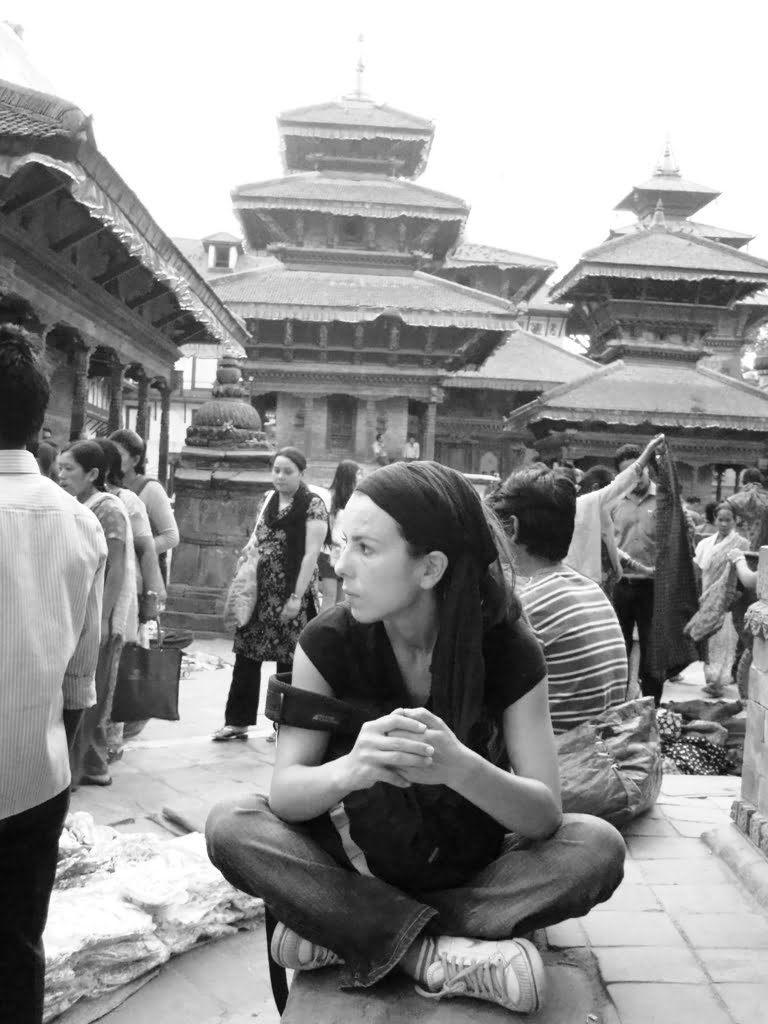
When I went to Nepal, I picked out a crazy present for my upcoming birthday. Having never climbed a single mountain in my life, I decided to climb Everest. The curiosity and mystery I felt at that moment still persists in every moment of my life.
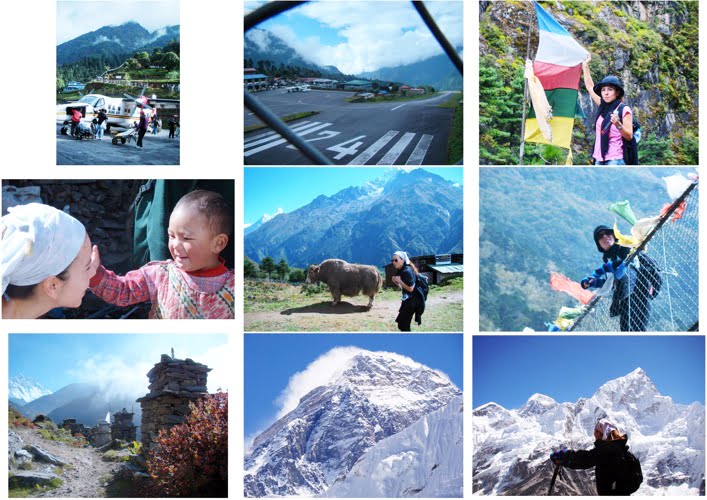
How did I plan my Everest trip? What did I take in my bag for the Everest trip? What kind of preparation did I make before I climbed the mountain?
“How many mountains does it take to climb Everest Base campsite and above? And you may be wondering such questions, “how many mountains have I climbed before?” Are you ready for my crazy answer? I know it sounds crazy to you, but I’ve never climbed a mountain before, and even when I was walking the streets of Kathmandu, Nepal, I didn’t have that idea. So you can imagine my bag was empty for this Everest journey. So, how did I make that decision?
What did await me on my Everest journey? How did I get to Everest? You can also find answers for all these in MY EVEREST JOURNEY. Now, before I make that decision, let me tell you how my Nepal journey started.
NEPAL JOURNEY
BEGINS…
If you want to go to Nepal and plan a different trip, you can start your journey from Iran like I do. Because plane tickets can be surprisingly cheap. If you think of going to Nepal one day, first go to Iran and travel there. Then go on to Nepal. You’ll see that all these destinations will be much cheaper than the one-way tickets you buy. Because plane tickets are much cheaper in Iran.
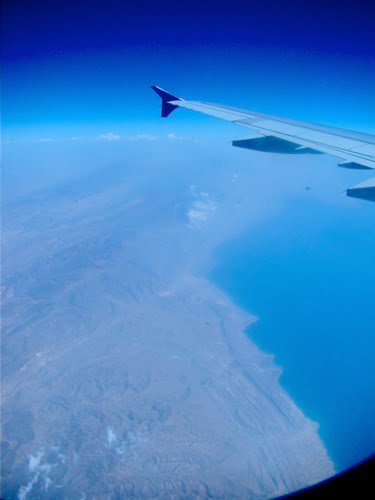
You can feel like you are on a minibus on a Nepal flight that you are connecting via Doha. The plane was much more chaotic, noisy, and stinky than my other travels. The food distributed in the plane seemed like slurry at first due to the color and density of the lentils. On top of that, the fact that people started to eat with their hands on the plane made things even more difficult for me. I always love to get on a plane after a rush, sit in a seat by the window, take a deep breath, and then look around and taste the food with curiosity. Yes I know, in-flight meals are absolutely incomparable to a delicious meal. But still, I can’t help but wonder “what will they give and how will they taste?” like an excited child. Well, if you’re like me, you may lose that curiosity on the flight to Nepal, but don’t worry, you’ll find them much tastier in Kathmandu than the meals on the plane.
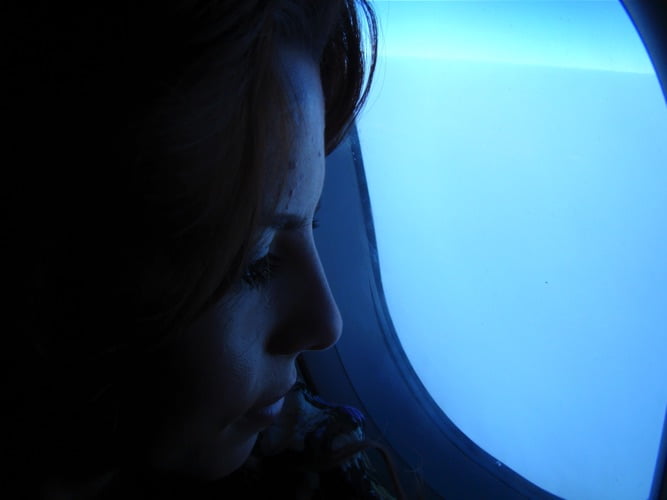
When I first landed in Nepal, the airport was under renovation and it was a bit of a mess. In fact, it wasn’t like we were leaving the international airport, but we were coming out of a small intercity bus station.
Be ready for what you’ll experience outside the airport when you get to Nepal. Don’t be surprised if a crowd suddenly rushes over you at the Nepal airport exit and tries to take you somewhere in English that you don’t understand.
For the first few minutes, we try to understand what happened, then we realize that this crowd and chaos belonged to the taxi drivers. I just want to warn you about one thing: We made that mistake; you don’t do it! We didn’t have the address of the hotel, we only had its name and although we insisted on saying its name they said there was no such hotel and they could take us to the hotel they knew if we wanted to. After all the effort we put in at that hour of the night, we had to say “Okay” even though we understood that something was wrong. Because none of them said, “We know this hotel, we can take you”. The only purpose of all of them was to take you to the place they knew and get a commission.
Make sure your address is written on a piece of paper or get in contact with the hostel or hotel you have arranged in advance. Give them the time of your flight and the flight number. Have them send their own cabs and pick you up at the airport exit. This is a much more comfortable way.
That night is one of those rare moments when I felt really scared. I kept questioning why I didn’t have the address in my hand, only the name of the hotel. In an old, ruined taxi with torn seats, we set out for the hotel where the taxi driver would take us in the middle of the night. I had an indescribable fear. The streets were dirty, dark, and there were police-like officers walking around with guns. Not to mention the homeless people who were drunk and vomiting in the street. Were they kidnapping us? We had no idea, and the adrenaline in my body was rising every moment. My Iranian cousin and I were staring at each other as we hopped down broken roads. It was his first real trip, too. I started asking, “why have I always been on a journey that’s going to get us in trouble?” I remembered my first trip to Iran. (Click here for my solo trip to Iran)
We came to a hotel, passing by the edge of a square from centuries ago, which I barely saw in the dark.
They put us in a dark room in a place that would require a thousand witnesses to call it a hotel, and there was only one toilet at the edge of that room. The room didn’t even have a window, we could see and hear the other room through the gap above the door. They put other tourists there like us. There was a thin, undersized light bulb that lit up the room. I slept uneasily all evening with the sound of horns outside. I could not get rid of the feeling that suddenly the door would open and someone would hurt us. I woke up from my sleep in the morning with the sound of the horn, which stopped late in the morning and increased at sunrise.
As soon as the morning came, we rushed out of the hotel and decided to find the hotel we actually wanted to go to, to understand where we were and how close we were to Kathmandu Square. We were 100% sure they were deceiving us, but there was one good thing: They really brought us to a place very close to the square.
When I went out in the morning, I realized that I had woken up to another century. Everything was very different. The fearful feelings from a movie-like night had disappeared, and instead we encountered the smiling Nepali people who opened their business in the morning. When we threw ourselves into the streets in the morning, our bodies were tired but peaceful.
Durbar Square

We started to explore the square with road fatigue. We were trying to figure out where we were. We were trying to find our way through the alleyways, and suddenly we found ourselves in a charming square. There were no people in the square at that time of the morning where they said they were taking money from tourists, and we discovered by chance the place in the back streets where the people enter and do not pay.
We were standing in the middle of the square, hungover, tired, and we were allowing an unknown feeling to fill our bodies. We didn’t get a map or a promotional brochure. Our only concern when leaving the hotel was to understand where we were and to find the location of the hotel we wanted to go to. Now we found ourselves in Durbar Square, the first stop of our trip. Our days in Kathmandu began at that moment without any plan.
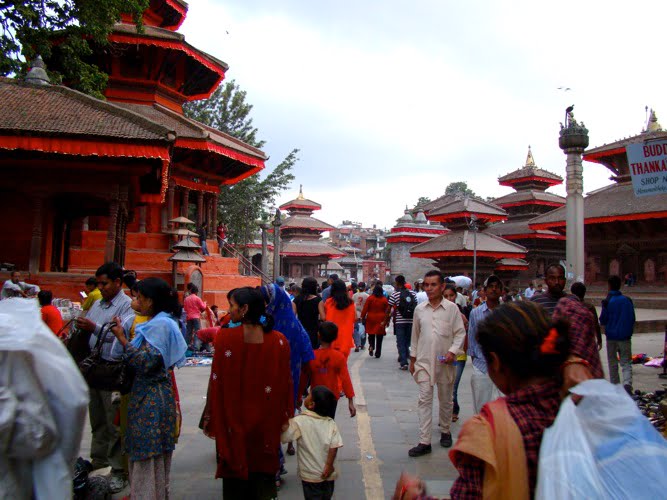
If you go to Kathmandu, Nepal, Durbar Square, which is one of the places you will definitely stop by, is the first stop of tourists. Many historical monuments including the Old Royal Palace, Golden Gate and various temples are located in Bhaktapur Durbar Square.
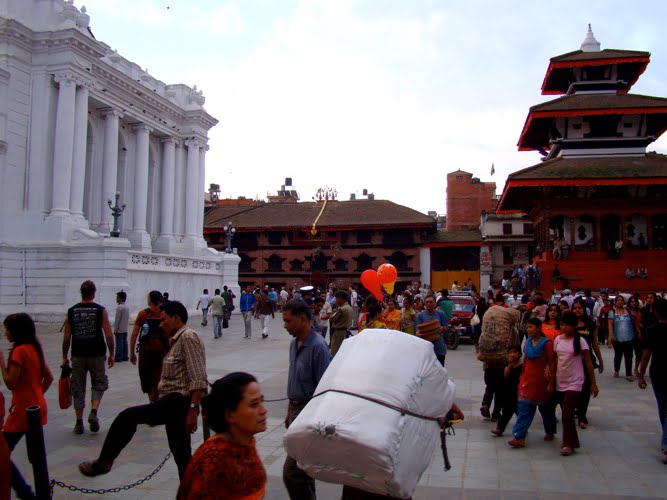
Yet, I do not know what the current state of the square is after the 2015 earthquake in Kathmandu, Nepal. I know some of the buildings were damaged and some were destroyed. If you have visited recently, I would appreciate it if you could inform me about the latest situation of the square.
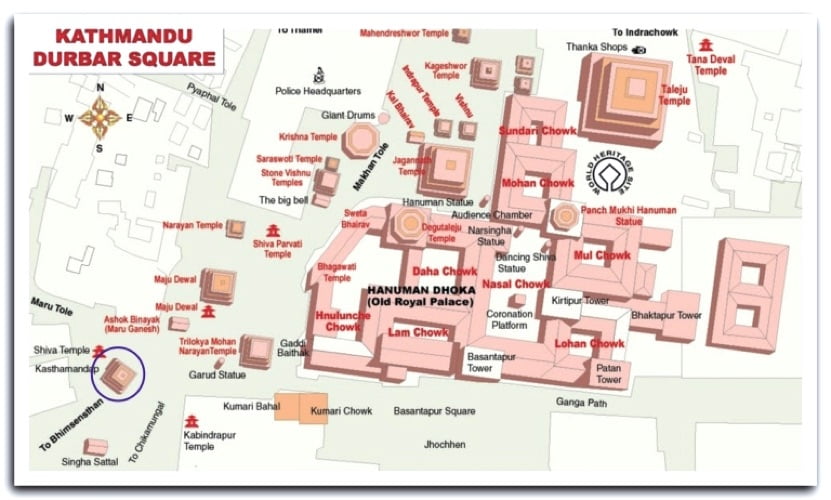
Bhaktapur Durbar Square; it actually consists of several separate squares, including Durbar Square, Taumadhi Square, Dattatraya Square and Potters’ Square. In addition, all these squares are included in the scope of UNESCO World Heritage Site.
MAJU DEGA TEMPLE (Queen Mother Temple)
Located in Durbar Square, Maju Dega Temple is a Hindu temple dedicated to Shiva. The temple was built in 1692 by the queen of Bhupetendra Malla, her mother Riddhi Lakshmi. That’s why it’s called the Queen Mother Temple. Due to its height, it has a considerable height in Durbar Square. After Taleju and Degu Taleju temple, Maju Dega is the tallest and largest temple in the Durbar Square area. Unfortunately, I learned that it was destroyed after the earthquake in 2015 and I was very sad. I’ll put a picture of it after the earthquake here.
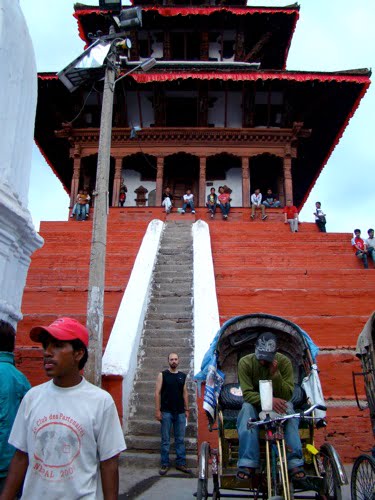
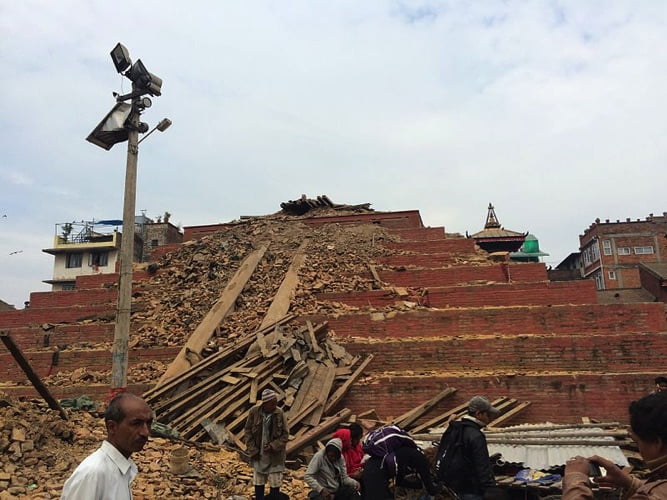
Kathmandu-Durbar Square- The large white monument next to Maju Dega Temple is dedicated to Kam Dev, the god of love and desire. Kam is the wife of Dev Shiva.
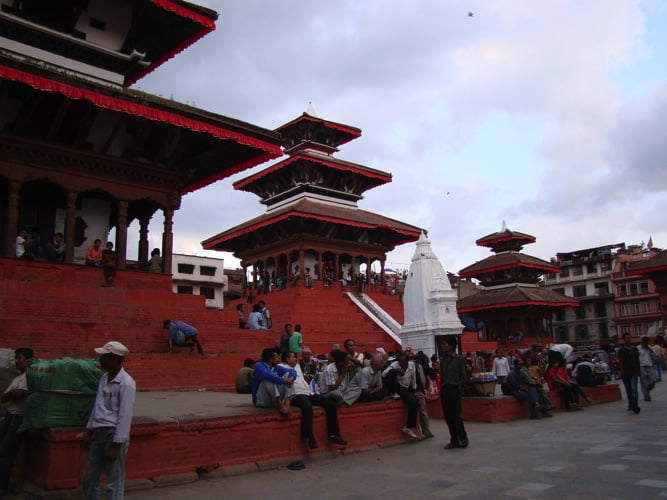
Right next to it is the other temple you see in the photo. The left side of the white monument is the Trailokya Mohan Narayan Temple.
Trailokya Mohan Narayan Temple
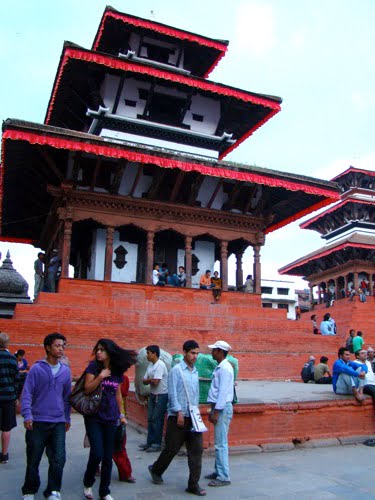
The temple next to the Maju Dega Temple is the Trailokya Mohan Narayan Temple. There’s a statue of the Garuda kneeling in front of the Trailokya Mohan Narayan Temple. Unfortunately, I learned that this place was destroyed after the earthquake. Since we took a detailed photo before the earthquake, I want to share it with you.
We were looking around curiously, trying to talk to someone and get information. That’s when we noticed the house of the child god in the square. Kumari Chow was a living virgin god and was also a child.
Kumari Chowk
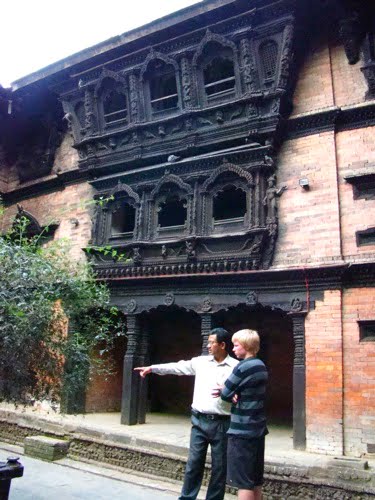
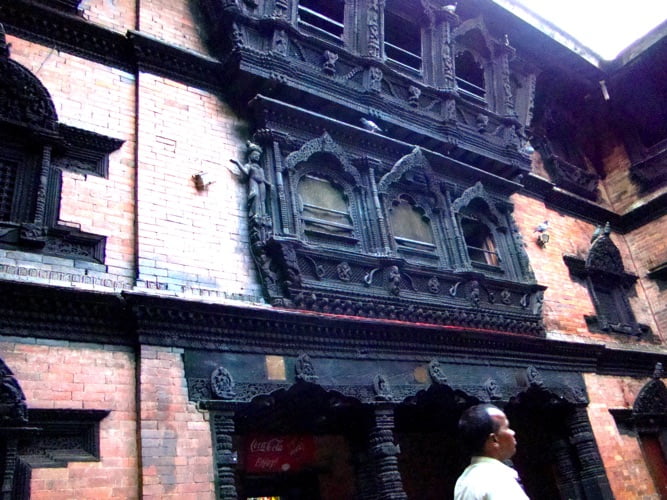
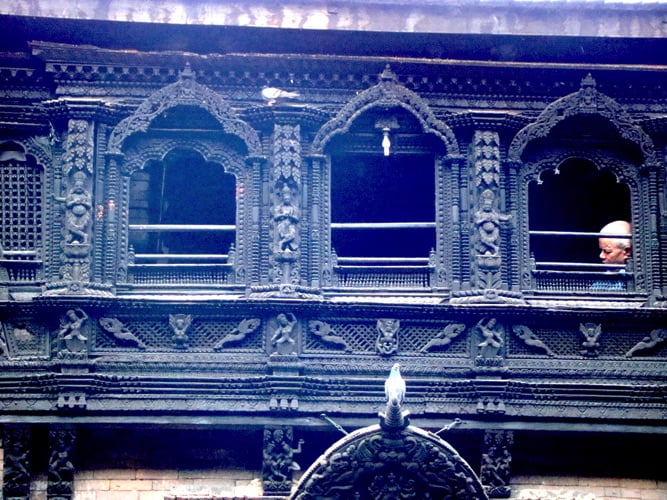
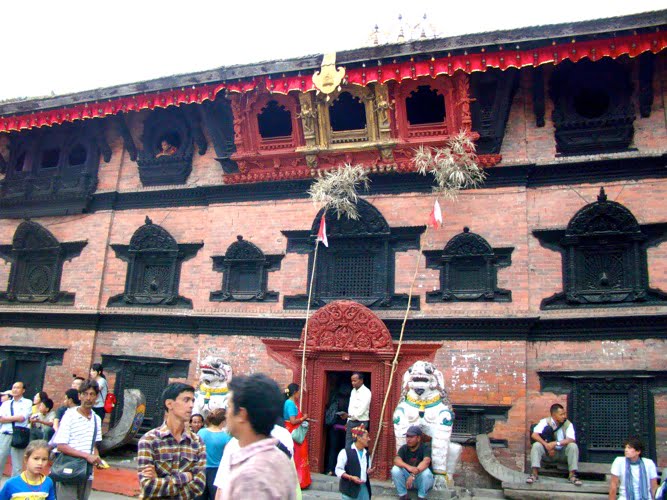
We’re coming to the Kumari Chowk house in Durbar Square. I don’t know if it’s a living goddess, but for me, this is the little girl’s home. There are two colored lions standing at the door. One of the lions was a female and the other a male, protecting this house. When we entered the courtyard, different energy greeted us.
These beliefs and the way that child was chosen affect us a lot. Kumari, the living goddess of Hindus and Buddhists in Nepal, is chosen from girls between the ages of 2 and 5. For girls whose “holiness” ends after they get their period, the real hard life begins after that. Unfortunately, it is said that they lead their lives in great loneliness after puberty. After the age of 13-14, they start a different life with a different identity. No one approaches them, as it is believed that men marrying Kumaris will be short-lived. Kumaris die in loneliness and poverty.
The girls, who were goddesses until puberty, go out of the wooden house several times a year. At the age of playing with their friends, they greet visitors on the palace walls. Do you think this could be an advantage? I certainly wouldn’t want my own daughter to be elected.
A Buddhist, a Hindu priest and a fortune teller choose the most beautiful and strongest of hundreds of girls. The living goddess Kumari’s sacred feet are carried by others so that they do not touch the ground. She dresses in red clothes and makes her hair in a bun, and an eye is drawn on her forehead, representing her power of perception. Placed in his palace in Dubar Square, Kumari can be visited by her family from time to time.
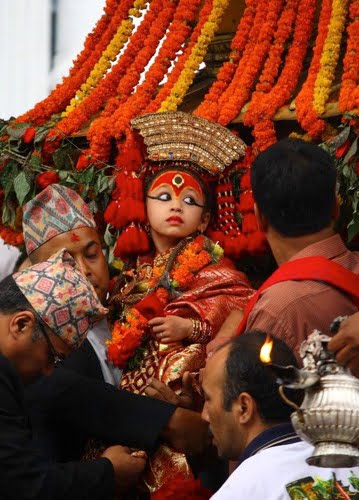
God, it’s not right for a child’s psychology to be destroyed. Especially when I heard that they were left alone in a dark cave when they were chosen, and the most fearless one was chosen by throwing cut animal heads and snakes in front of them, I had goosebumps. If you think that they will return to a normal life when they menstruate, you are wrong because they believe that people who marry Kumaris will have a short lifespan. So how many men marry Kumaris under this circumstance? A lonely life awaits them. Without even thinking that I would see Kumari, I was sitting there trying to understand all this in my head, and I noticed a kid coming towards the window. She was Kumari and she was waving at us out of the window. I was very excited to see her in her real form while I was trying to figure out the fairytale-like story being told in my head, so I stood up and waved to her.
I wanted to run into that house and take her from there to a huge playground where a lot of kids were screaming and playing.
At that time, Kumari Chowk suddenly ran inside and we left with mixed feelings.
Thoughts of Kumari Chowk in my head were dissipated when we suddenly found a tiny, bright, delightful boutique hostel. The penthouse created such a peaceful feeling for me that we left the hotel we had chosen before and immediately changed our plans to keep up with the current situation. Realizing that staying in the moment is more important than making serious plans here, we took our belongings from the other hotel and moved to this tiny, heart-warming hostel.
And from that moment on, Kathmandu started to look warmer and more beautiful. Our tired bodies were filled with energy again.
Then we stopped by Durbar Square many times for different reasons. I want to share with you a few more photos of temples. As a matter of fact, at first we were very interested in the symbols and statues on and in front of the temples, but then we got used to it so much that it all seemed normal to us.
Kala Bhairab
Don’t Lie to me!
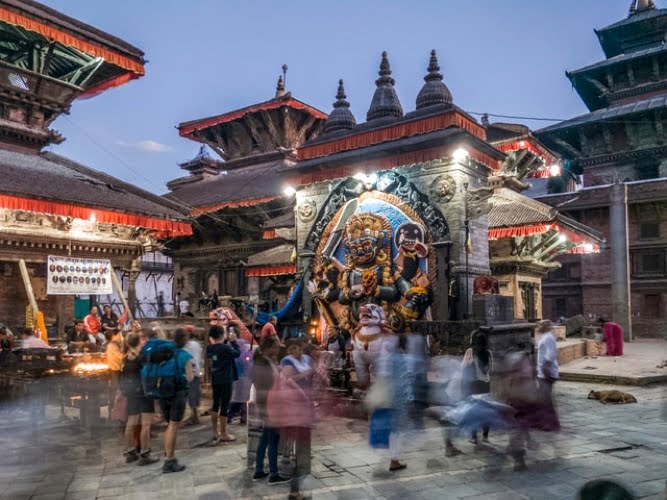
One of the well-known figures of the square, which caused a colorful image in Dubar Square, is Kala Bhairab.
It is said that lying while standing in front of Kala Bhairab will bring instant death. It has also become a place where people swear by the government for the truth. It represents the destructive god Shiva. The crown on her head is already made up of skulls.
Mahendreswar Temple
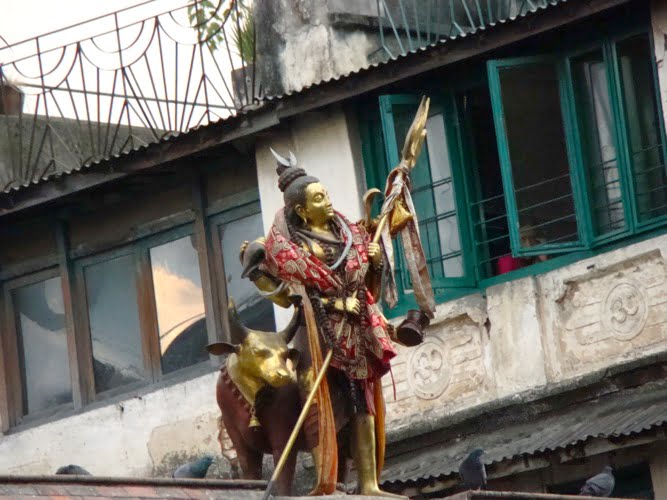
There is a statue of Shiva and Nandi above the temple. Nandi is a bullish-looking Hindu god in Indian mythology who is ridden by the god Shiva and is the protector of the god Shiva. You can see these images in front of or on most Shiva Temples. It is said that he expelled the devil with the spear in his hand and protected his temple. Since there were temples everywhere, we stopped looking at all temples after a point.
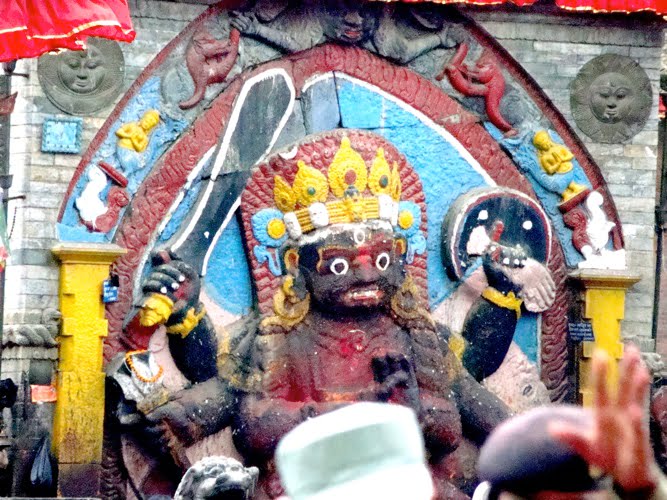
King Pratap Malla Column
The prosperity that King Malla brought was responsible for most of the places around Durbar Square after his reign. His reign was seen as a cultural and economic peak. This column in the picture you see belongs to him.
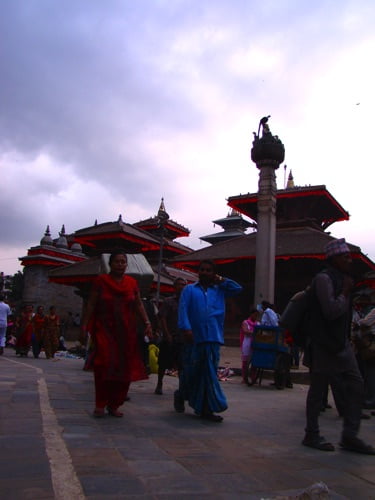
The city is represented as a lotus and King Malla, his wife and children are placed on it. Of course, since he has two wives, he is surrounded by wives and five sons on both sides. His little boy is in front. So it is really difficult to figure out these columns and statues in Nepal. Everything seems so complicated. There are many gods, many kings, many cherished symbols and animals. When this is the case, you can see the symbol and statue of everything.
Thamel Region
Get ready to get lost in the streets!
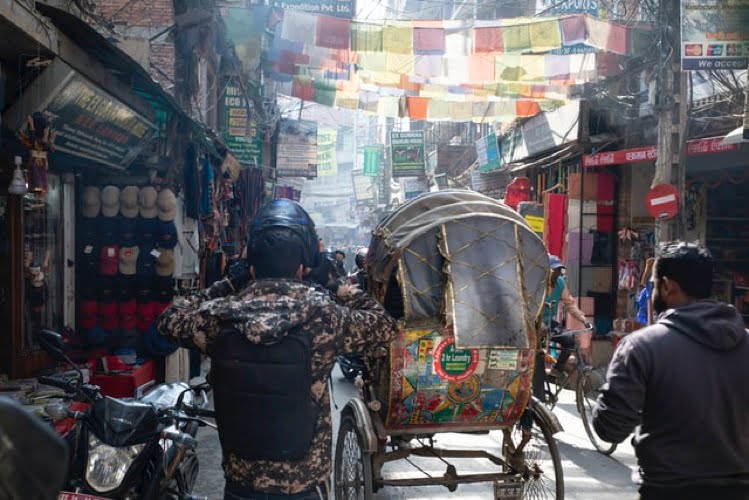
The hostel I stayed in is in Thamel, the tourist center of Kathmandu. I don’t remember how many times I wandered around Mandala Street, which has a special market for tourists. We probably wandered around the streets of Thamel, known for its tourist-specific streets and colorful images, 5 times a day during my stay. This is an area where you can taste different flavors, find different souvenirs for your loved ones, buy The Nort Face brand and similar products much cheaper than you can imagine.
One day, you find yourself looking at handmade papers, embroidery on paper, handmade paper lamps for hours; another day at cd shops playing mystical music with incense shops, oil essences. In other words, you can spend hours in a store that attracts your attention in the Thamel region.
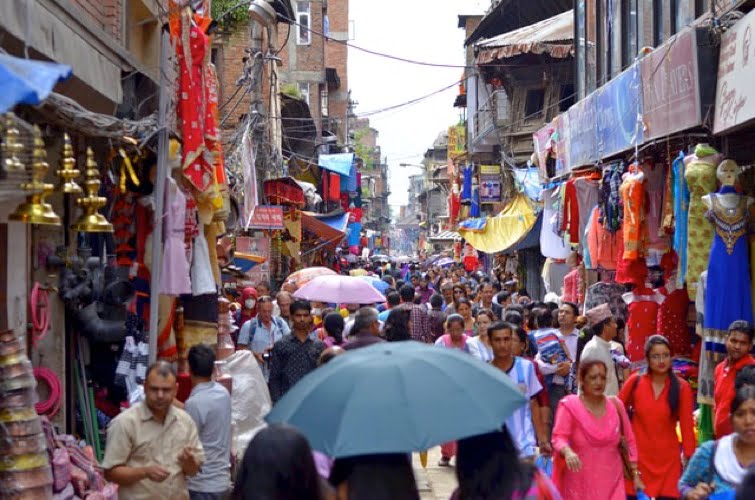
You could be surprised to see that the product you think you bought at a cheap price by entering a shop is being sold for cheaper in two shops next to it. I think you could experience this situation in Nepal, which every traveler has experienced at least once. Because bargains are made with big numbers, not small numbers like in your own country. It is useful to visit the shops for pleasure and learn the prices beforehand. Keep in mind that you can also buy products for a third of the amount you’re told.
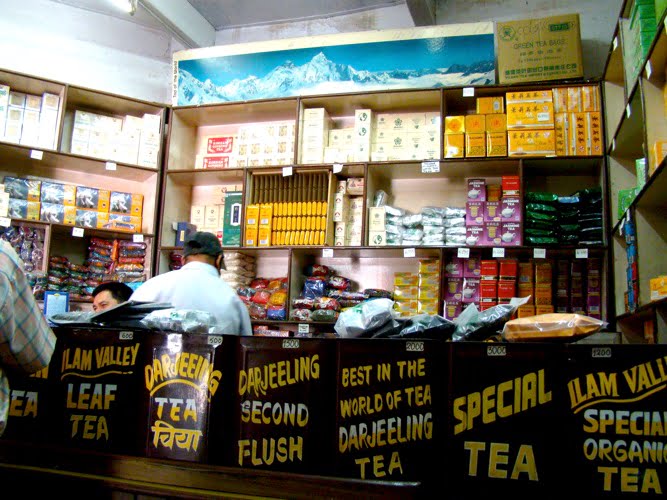
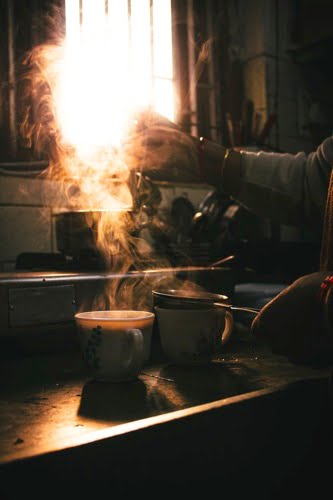
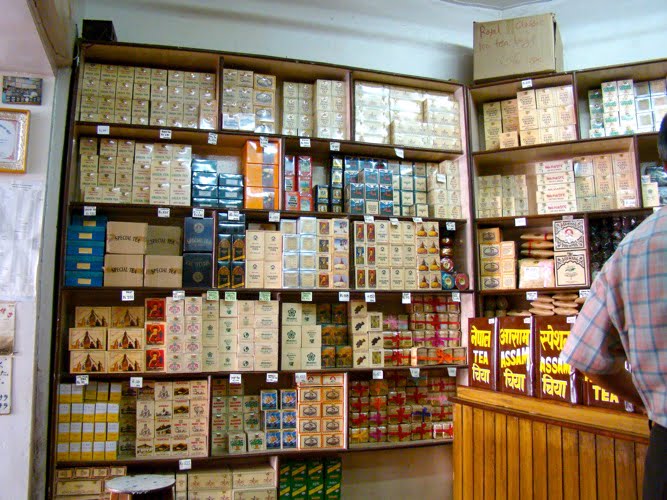
Also do not return without buying natural incense. Because when you think that there is not many natural handmade incenses in our country, this place seems like an incense paradise. Black and chemical incense may smell good, but they’re not really very healthy. In the Thamel area you can find handmade, natural, wonderful incense. Personally, I could hardly get out of the smokehouses, where I was surprised and lost myself in what to smell, buy, from patchouli to sandalwood, olive to amber.
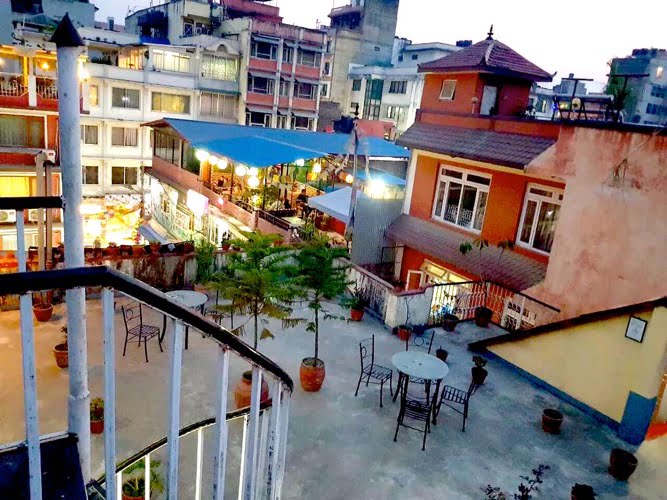
In the evening, we drink our beers under the tiny lights on the upper floor of the hostel. We leave the tiredness of the whole day and all the fear of the previous day there, accompanied by the smell of incense around. Then a deep sleep awaits us.
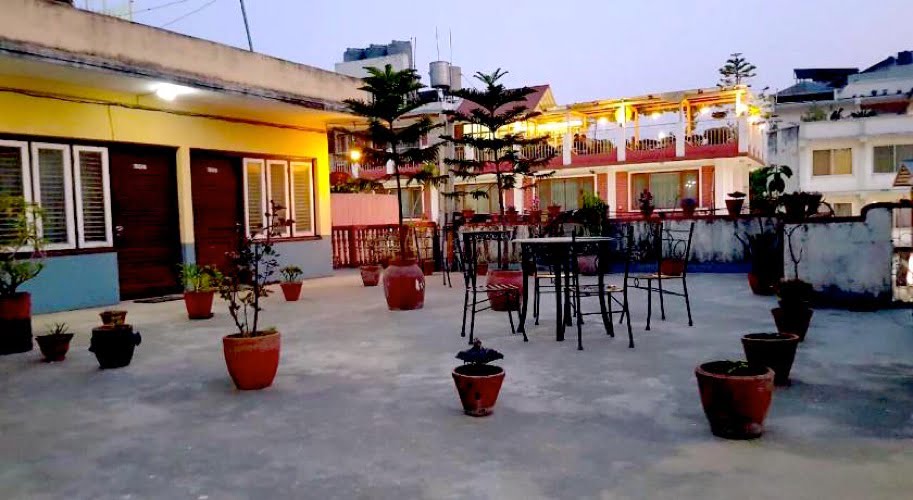
We start the day early the next morning with intense horn sounds again. Be prepared for these horn sounds, which are the sign language of cars. After a few days, you get used to this noisy symphony, in which vehicles understand by honking instead of using signals, and you no longer hear them.
OR2K Café
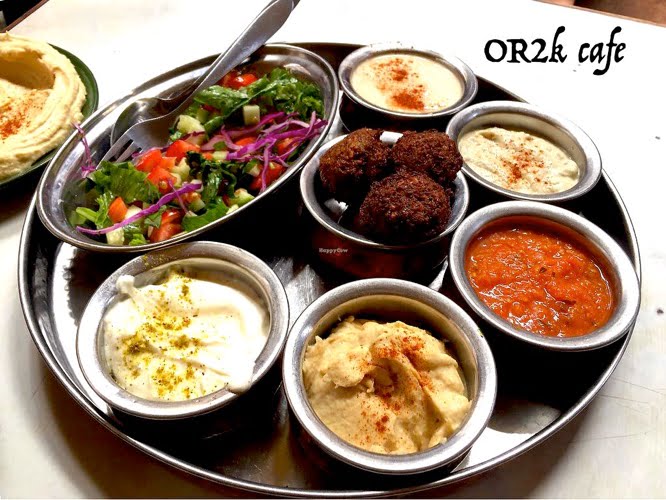
OR2K Cafe, which we found through my research on the internet, took us from the center of Thamel to a completely different land. When we discovered this place, we felt like we had found gold. Because we generally preferred to eat Nepalese food in local places. But if you come to this cafe as soon as you land in Kathmandu, you will definitely not understand what I mean.
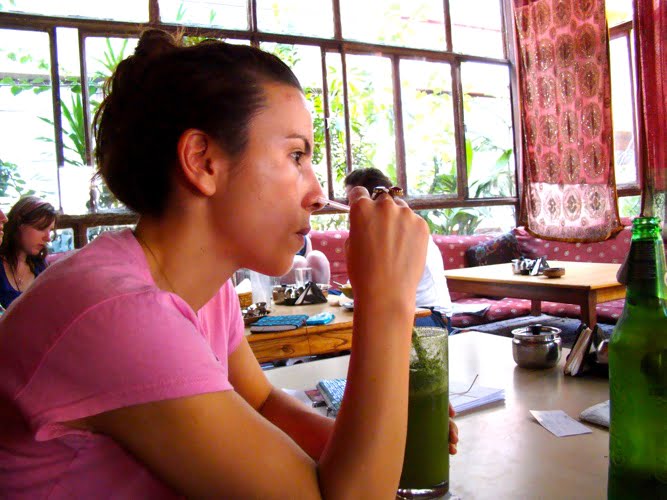
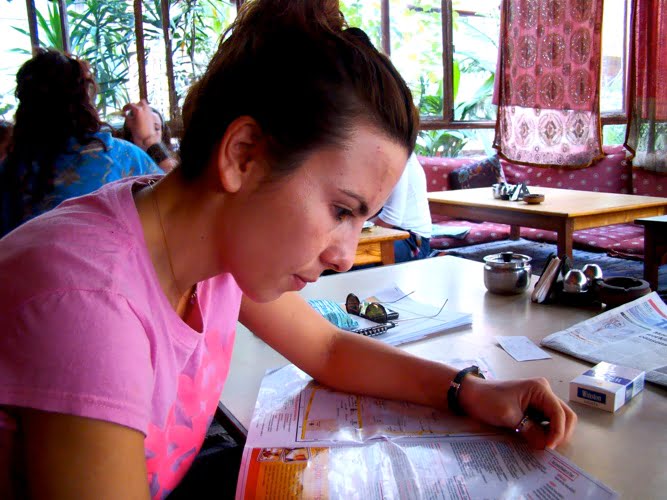
You might even think about why I’m making exaggerated sentences. Let me put it this way, we discovered this place after the absence there and the strange food we ate. That’s why the music playing inside, the food with different options, and the delicious menus made us feel like we found a mine. When you walk for hours, get tired, take off your shoes and throw yourself on the big cushion on the floor, you’ll know what I mean.
There’s a lot of tourists in there from all over the world. The food was satisfying and delicious. In fact, we used to come to this cafe when we were going to make a new plan or evaluate the maps we have.
The moment we enjoyed the most was coming here to have a beer as if we had won after our Everest journey. (Those who are curious about the Everest journey)
If so, let me tell you about another restaurant I remember.
La Dolce Vita
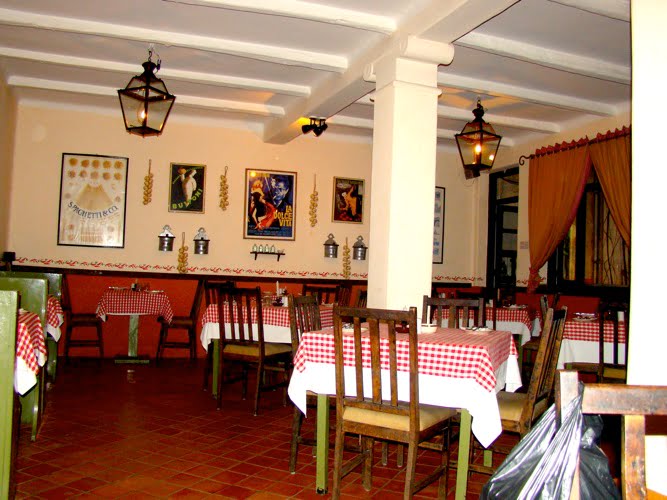
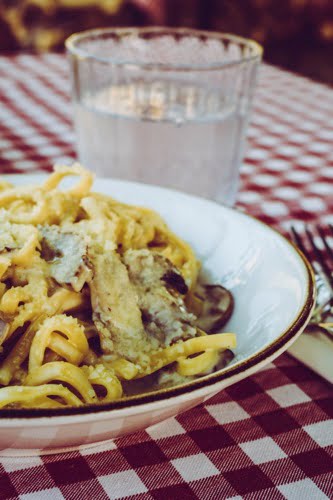
After spending a long time in Kathmandu, we started to look for different flavors. For example, pasta with a great sauce, salad… That’s when we discovered this Italian restaurant. I’m sure that new places have been opened now, but under the conditions of that day, this place was very good for us. When I went to Kathmandu, like many tourists, I was going to an internet cafe. I was setting up and taking notes on the internet about what I was going to do and restaurants, and the next day I was trying to find this place. It was my greatest pleasure to go to the cafe in the evening and share them on Facebook. As soon as I found the Internet, I was calling my parents, sharing all I’d been through. Now, when I stop and look back, I see that it’s a different kind of joy. It was a different pleasure to go to internet cafes on trips abroad where we did not have a phone all the time, where we could not call the person we wanted and where we could not use social media.
Let me tell you about a few other restaurants we’ve got in mind. In this way, you have the option to distract your mind a little and make the process more enjoyable in every new emotion and experience. These were the things we found on the dates I went, but I’m sure now much newer and better options are waiting for you. I think you should definitely visit the tripadvisor website first. I’m sure most of you know about this site. It is a great website that allows you to easily discover the best places you can find with the reviews and points given by many travelers in travel, accommodation, food and drink.
Here are a few restaurants I like:
-Forest and Plate
-Rosemary Kitchen Restaurant&Bar
-Spize
-White House Kitchen
-Roadhouse Cafe Thamel
-Electric Pagoda Bar&Cafe
-La Casita de Boudhanath
-Marco Polo Restaurant
-Nepalaya Rooftop Restaurant
Pashupatinath Temple
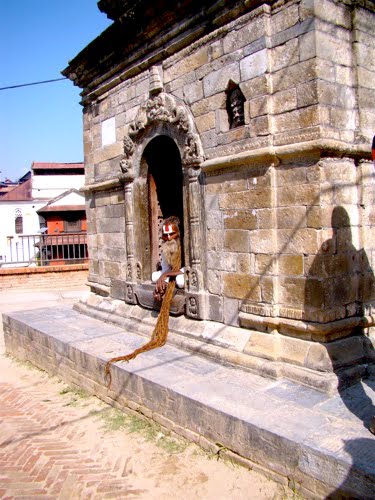
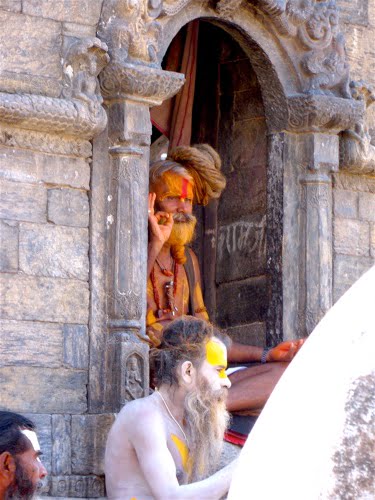
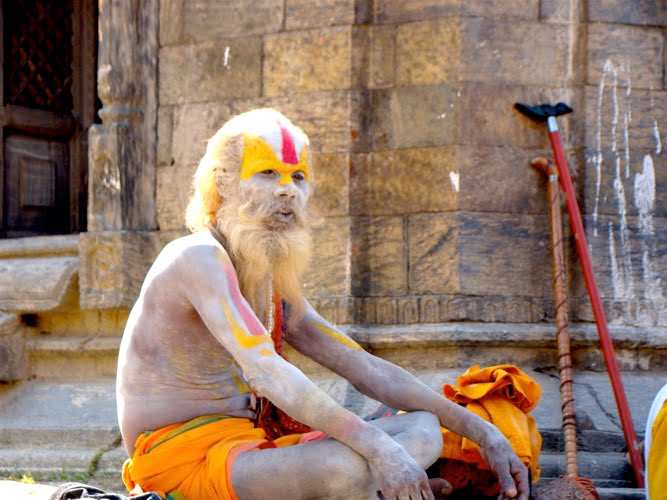
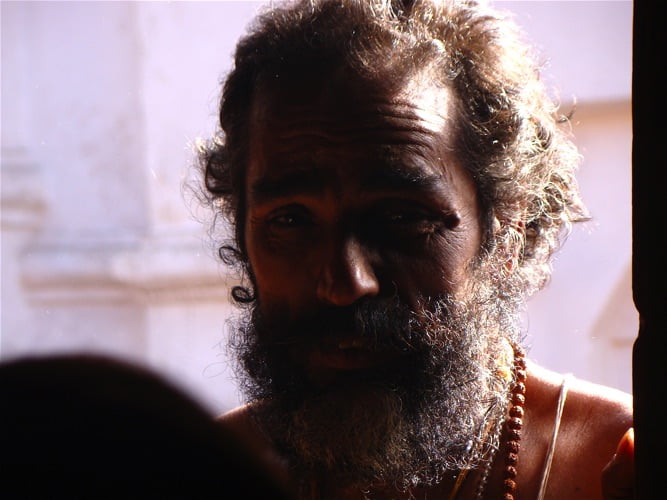
The next morning we find ourselves in temples at cremation ceremonies. As someone who has never seen a dead person in his life and grew up in a country where the dead are buried according to Islamic values, I am very affected.
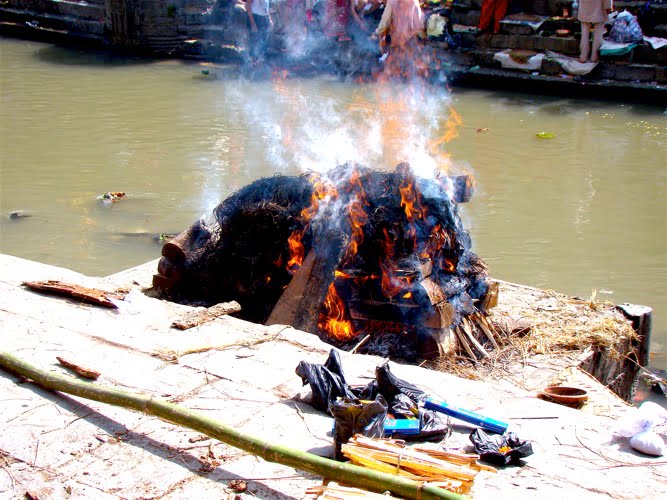
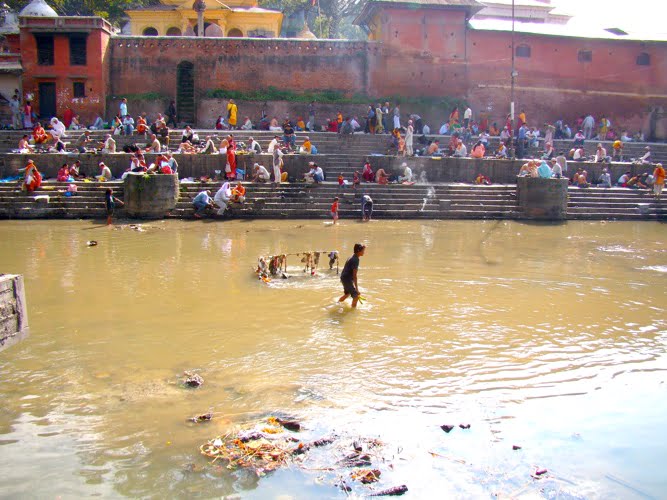
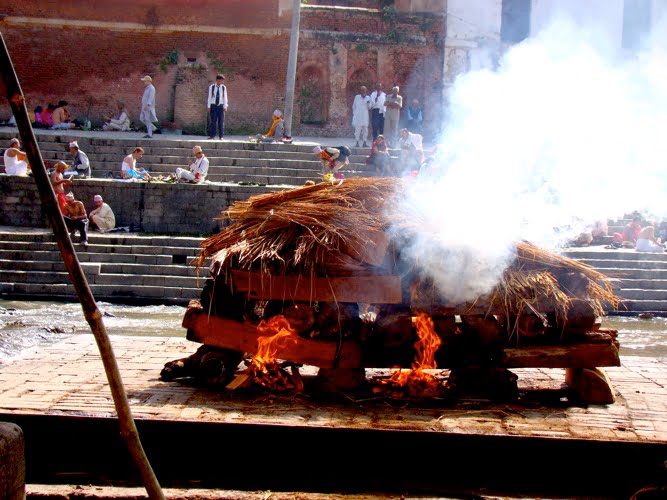
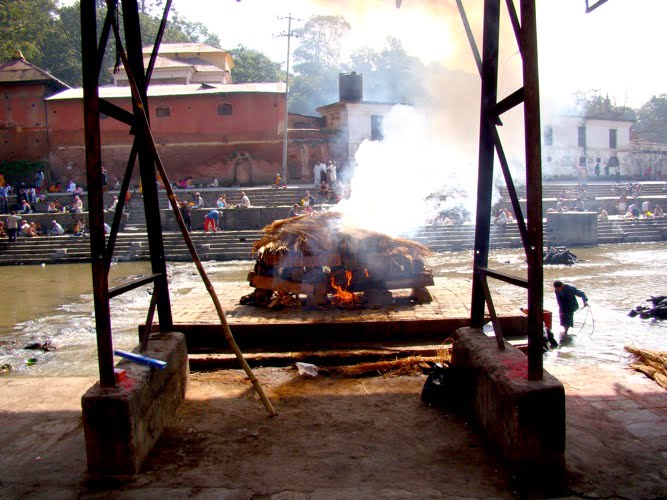
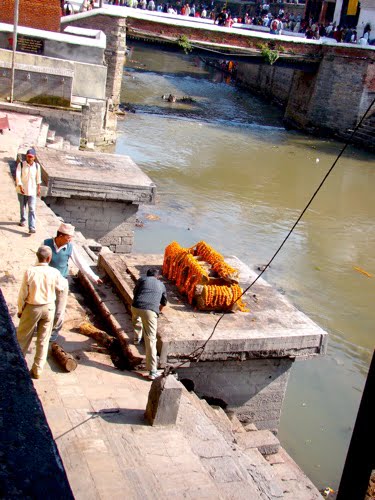
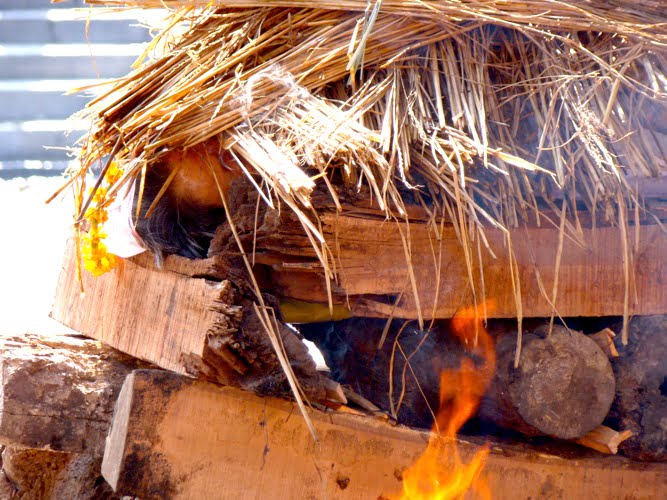
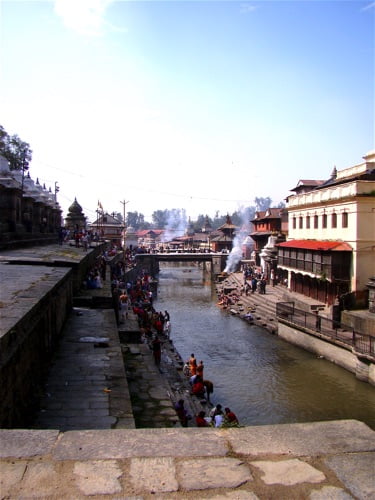
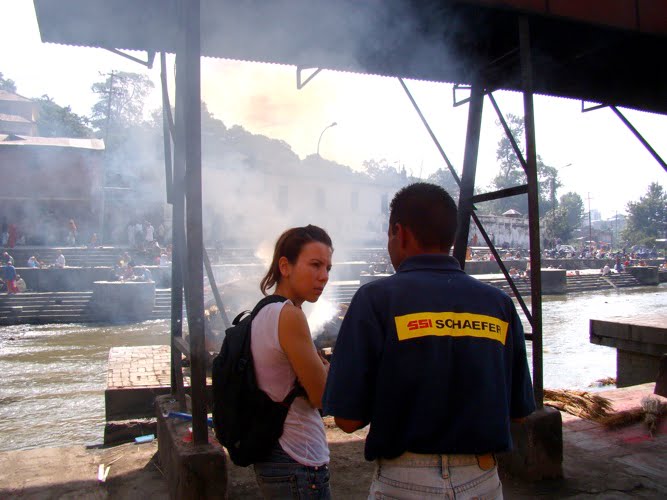
I can’t get rid of that smell that comes out when the dead are burning from my memory for a long time. Even after returning to my country, I could not stand the smell of barbecue because only one thing came to my mind: Cremation ceremonies.
The Pashupatinath Temple, built 1600 years ago, is a temple in Kathmandu dedicated to Lord Shiva, the god of Hinduism. Pashupatinath Temple is a UNESCO World Heritage Site and is one of the four most important religious sites in Asia. It is also one of the largest temples in Nepal. It is located on the banks of the Bagmati River, a tributary of the Ganges river, 3 km northwest of Kathmandu. The large golden statue of Nandi-Shiva’s bull is also seen here. You can see hundreds of thousands of people from Nepal and India here during the Maha Shivratri festival in the spring. I fact, I think these festivals were canceled after the pandemic.
While the tourists were watching the cremation ceremonies, I found myself in the ceremony in a way that I couldn’t understand. The attendant answered all my questions. And then the burning process began with the lighting of kindling that was put in the mouth of the dead.

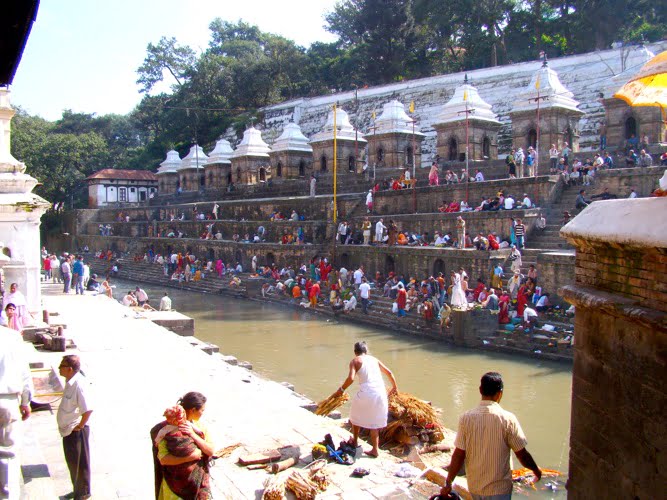

The burning of Hindus takes place in elevated areas along the river. The rich are burned on one side of the river and the poor on the other. In fact, when I looked at it from the outside, I didn’t see any difference. There were only 10 meters between them. They were burned in the same river in the same place. I asked the attendant what the difference was. He said that better quality wood was used and that it was burned in the part where the flow of the river came from and left in the river. I looked at the place he called the upper part, there was maybe a distance of about ten meters in between. They pay high prices to be cremated in this part. It’s a place where the rich and the poor really lose their meaning. It doesn’t make any sense to be burned with better wood or to have my burned body given to water sooner. I don’t think money means anything when it comes to death in my own world. I looked at the river with bewildered eyes. I didn’t know what to think when I saw women washing clothes at the bottom of the river.
Monkeys were all over the temple again.
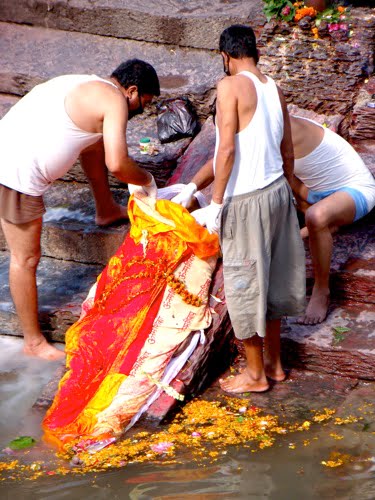
The feet of the dead, laid on specially prepared logs at the Pashupatinath Temple to Rajandi, were first washed in the river and their relatives said goodbye to the dead. The wood to be used to burn was calculated according to the weight of the dead. They put a gel in the wood. I asked the attendant what the gel is. He said they sprayed that gel so the wood could catch fire faster. Afterwards, the deceased was dressed in special clothes. After being lubricated with sandalwood oil, the dead were wrapped in white cloths, which are the symbol of purity, and kept for a while.
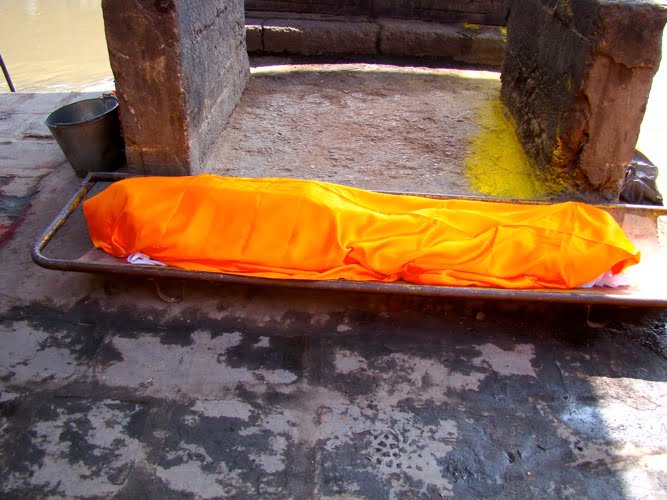
While Hindu priests, called Pandits, prepared the body for cremation, relatives waited quietly around him. The eldest boy, wearing a white outfit, set fire to the woods But if the deceased is a woman, the youngest boy does this. Then the person who set it on fire shaved his head. The process of setting on fire was made from a piece of wood placed in the mouth of the deceased. This burning took an average of three hours. Then all the ashes were poured into the Bagmati River, a tributary of the Ganges river.
The dead man’s wife continues the ceremony by coming to the temple for a year and offering rice and flowers to the gods. They are also said that the person in the white suit who burned the dead was dressed like this for a year and should stay home for 10-15 days after the ceremony and not talk to anyone.
It was as if everything was very natural and there was a ceremony as if there was no death.
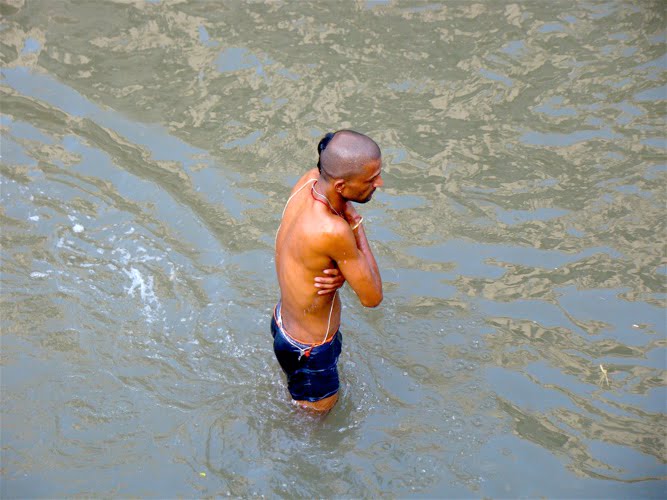
That was something I’m not used to having my view of death questioned. I don’t understand how when someone dies in my own country, when people are devastated, they take it so natural here, reacting as if they were sending the person they lost on vacation. Okay, they had different beliefs. I know, but even when someone you normally love goes away, they can cry, and the fact that they’re so comfortable with death makes me feel a lot more normal than having those ceremonies traumatic.
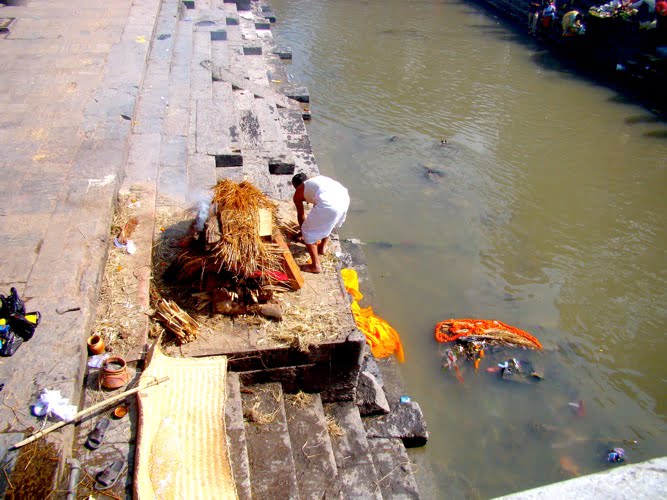
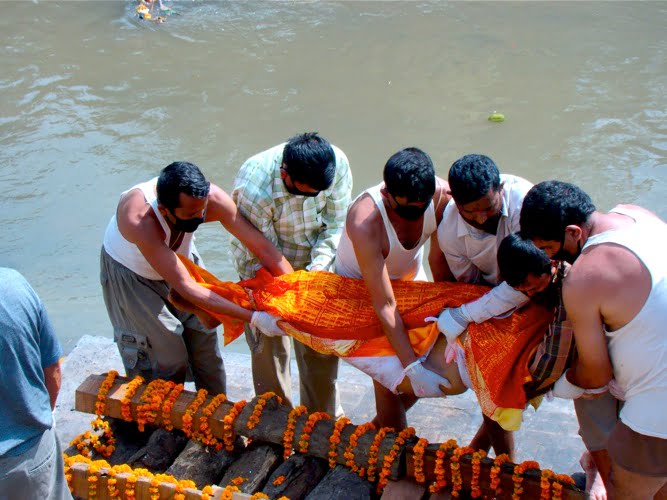

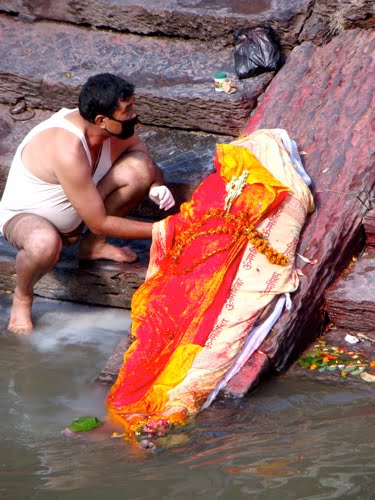
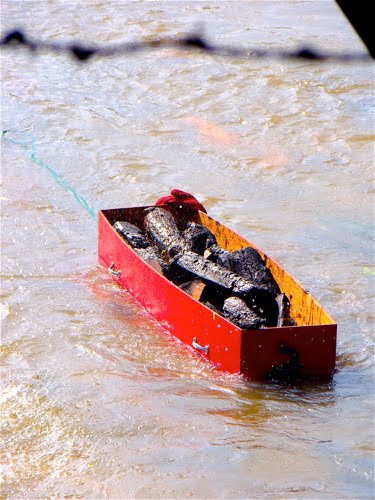
Tourists were not allowed to enter many places, but somehow the sadhus invited me to their room and offered treats. I’m not talking about sadhus sitting on the edge of the temple for a photo. I’m talking about sadhus living out of sight in a small room. I was also surprised that I was treated as a head guest as if I was supposed to be there and not a tourist.

I sat next to them in order to spend time with the sadhus, not breaking their polite invitation. The room was smoky, you can imagine what they were drinking. They offered me Nepal tea they made especially for me and cigarettes. I politely refused to smoke and took one of their teas. The room is was so small that cigarette smoke was everywhere. Of course, it was not a normal cigarette they smoked. Weeds were everywhere in big bags. They were so kind and welcoming to me, they were always offering me something. We were talking.
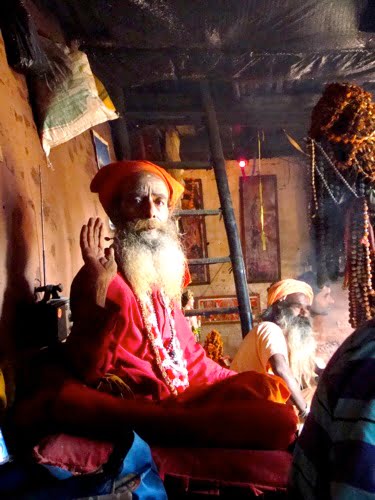
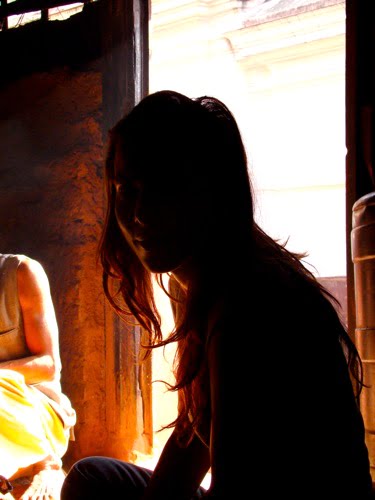
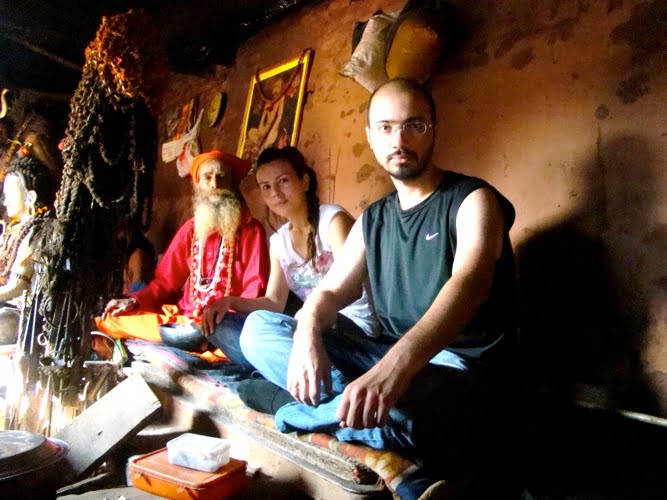
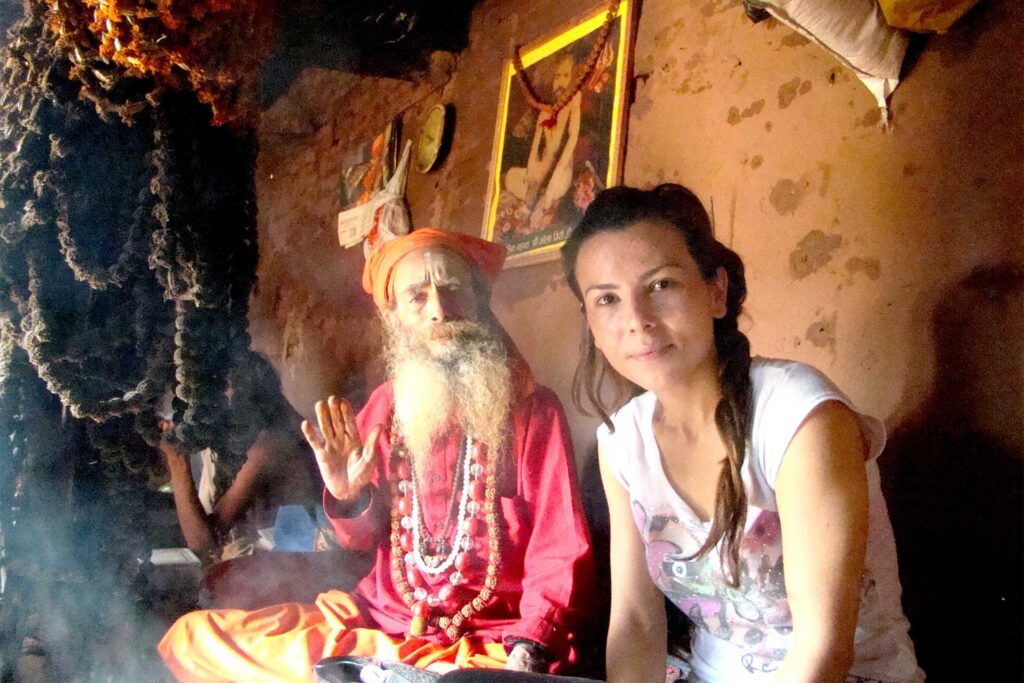
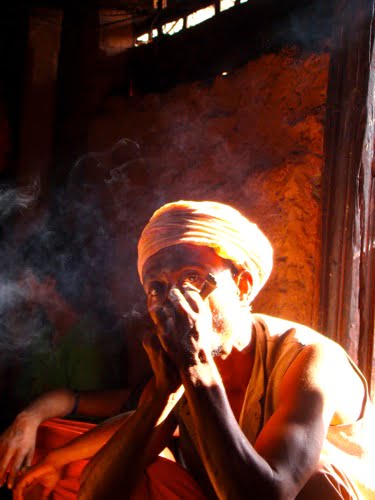
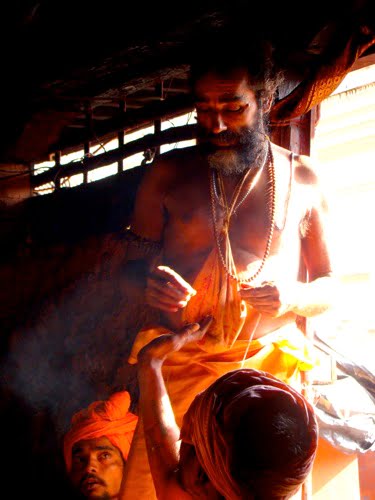
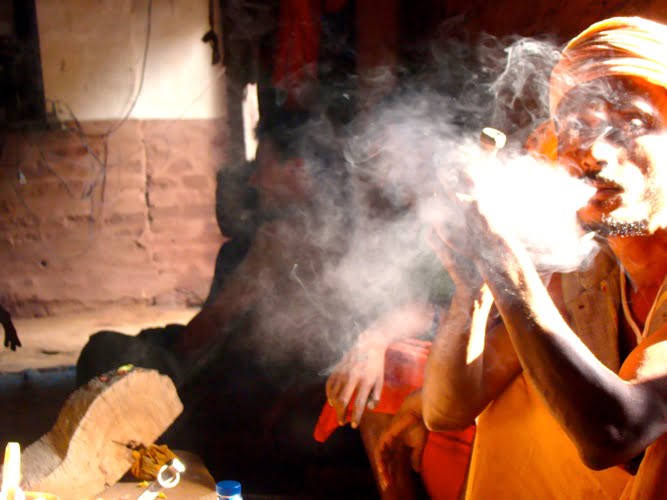
I learned that they live and worship here, they spend all day here, they have no expectations of life. I listened to them for minutes and thought. I started to feel different with the effect of the smoke anyway. My cousin was with me. While we thought we were inside for five minutes, we realized that we had spent an hour. I think if we stayed a little longer in the room, we might come to the conclusion that we would never leave the room.
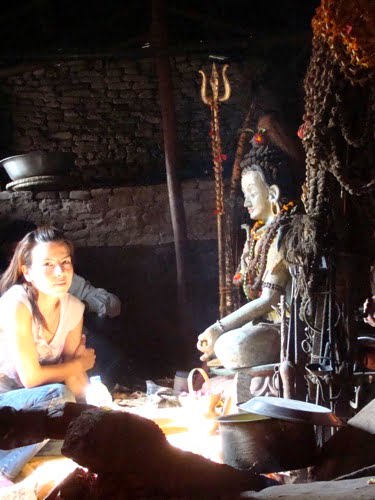
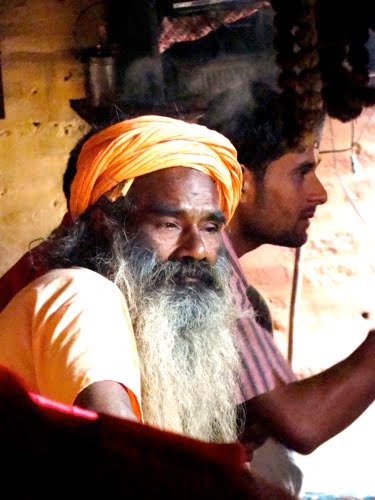
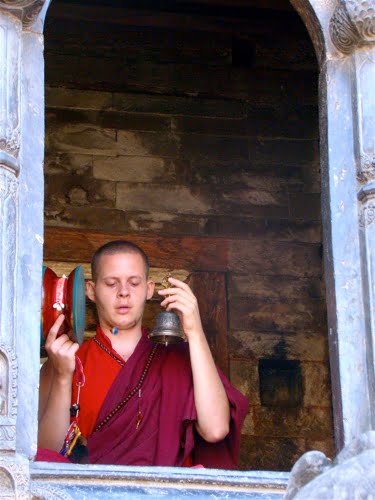
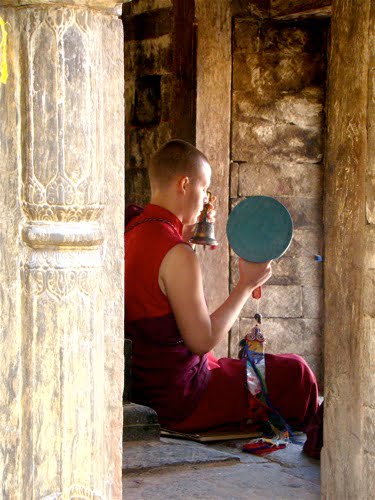
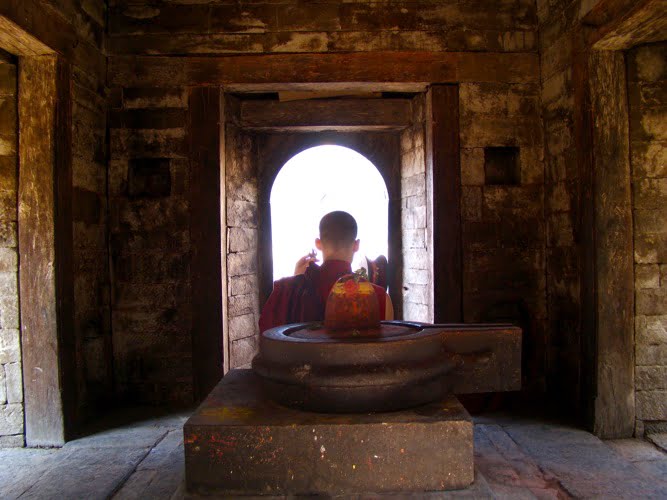
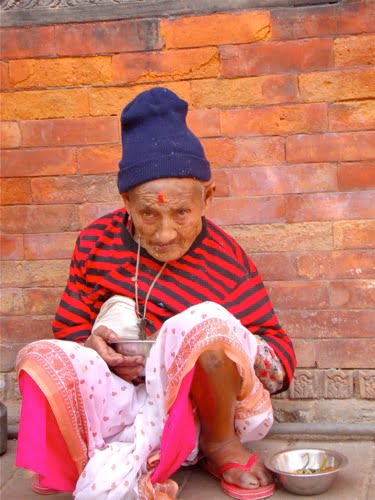
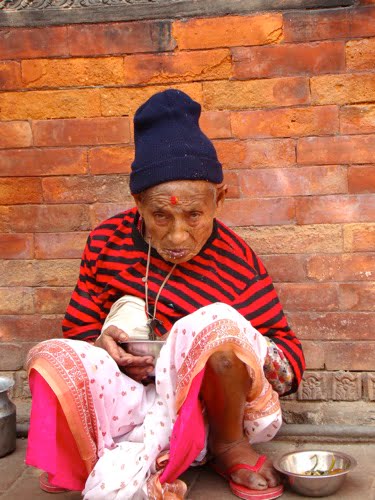
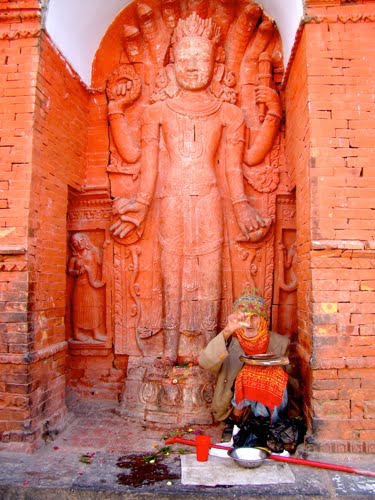
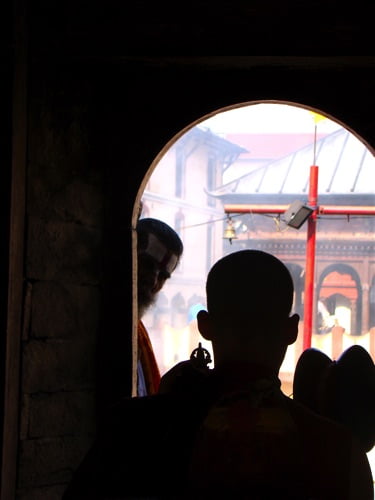
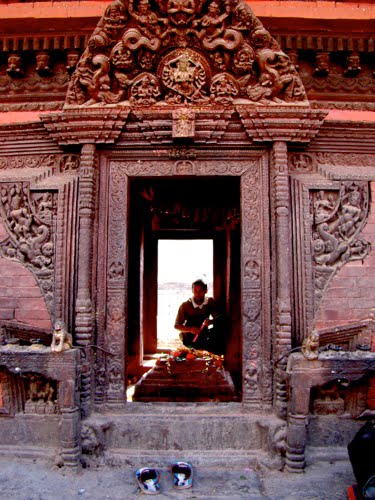
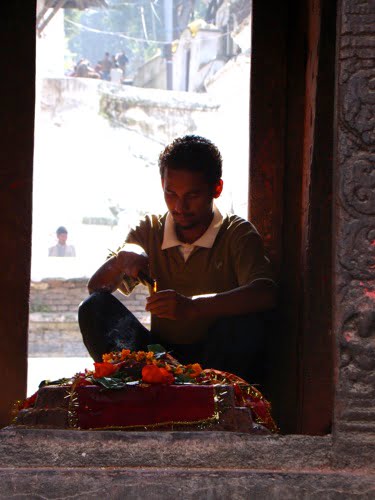
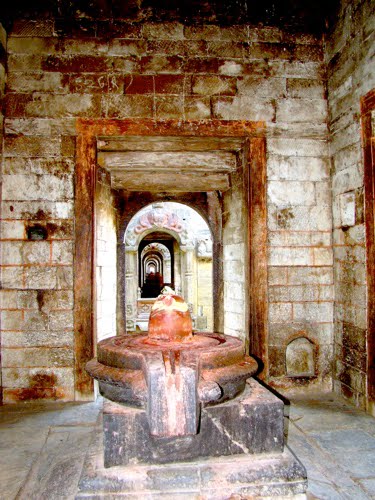
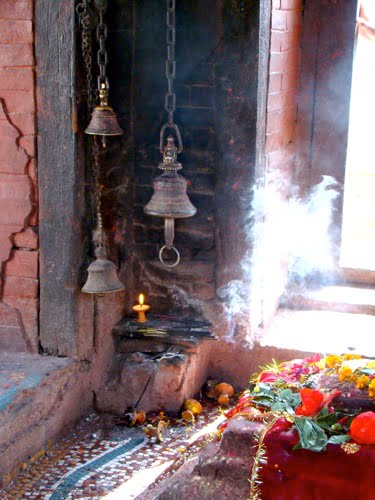
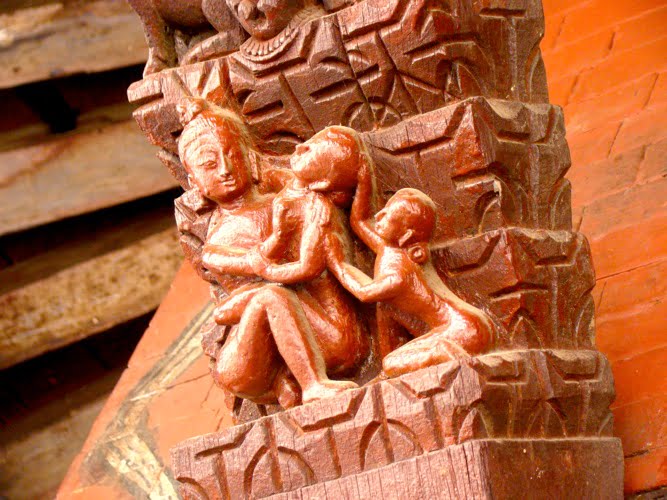
Apart from the Saddus, there are poor and old people who await death. I can’t imagine what it’s like to wait for death in a place where people are cremated every day. But we’re learning that waiting here is very important to them. I looked at some of them, maybe they had more time to die, but they were waiting for death instead of living. Even if I try to look at it from a truly religious point of view, I don’t get it. Life is there with all its energy, and you’re focused on the aftermath of life. It’s hard to understand…
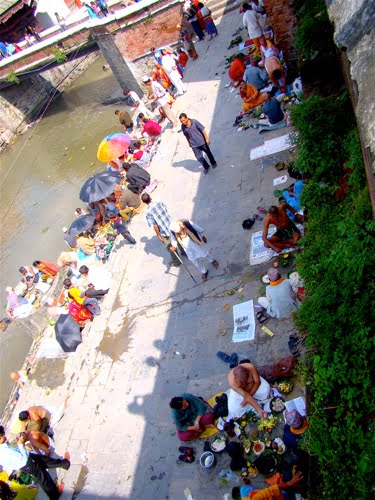
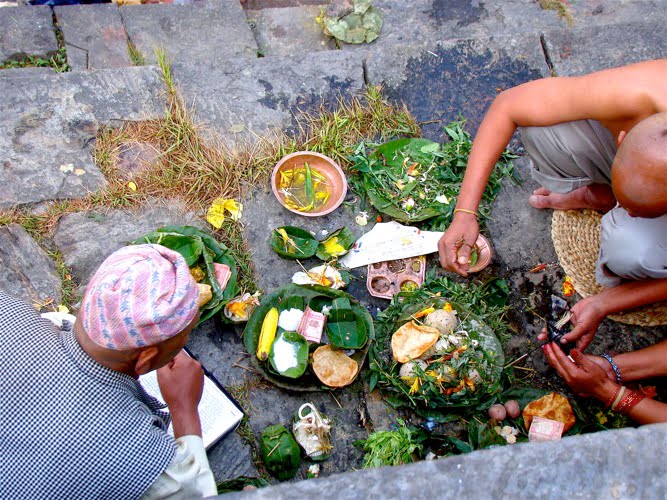
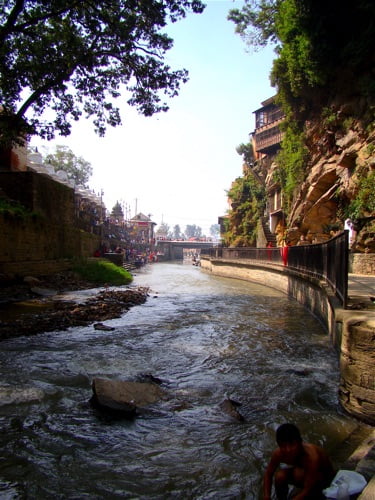
Such an experience took our whole day, then we went to the center again and tried to make sense of our experiences by having a cold drink in a cafe where calm music was playing. We were already so deeply affected that our soul and body were still there.
When you find a place where you feel comfortable in Kathmandu, you definitely throw yourself there to think about your experiences over and over again. The place we escaped to in such situations was the OR2K Cafe, which I mentioned above. We tried to cool our inner fire by drinking one of their cold, mint, cucumber, fresh drinks.
Pashupatinath Temple, which was closed due to the coronavirus, reopened on 16 December 2020 after being closed for nine months. You’d better check again before you go. It may have been closed again due to pandemic conditions or tourists may have been banned from entering.
Bodnath Stupa
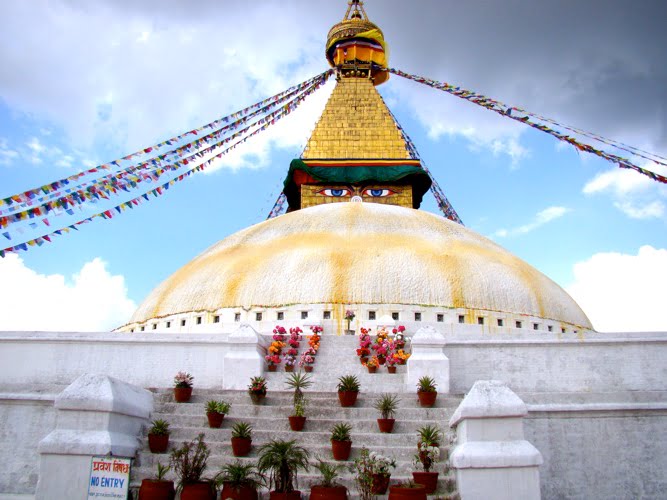
Located in the center of Kathmandu, this magnificent Buddhist temple, Bodnath Stupa is a must-see. Boudhanath Temple is the largest Buddhist temple not only in Nepal but also in Southeast Asia. You can see the Buddha’s eyes all over the temple. It is not possible to enter the temple, only Buddhist clerics and monks can enter. You really feel like you’re in another world.
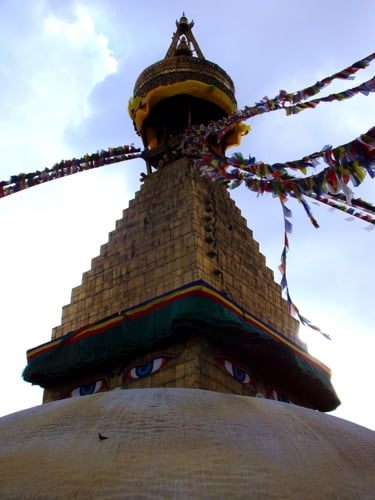
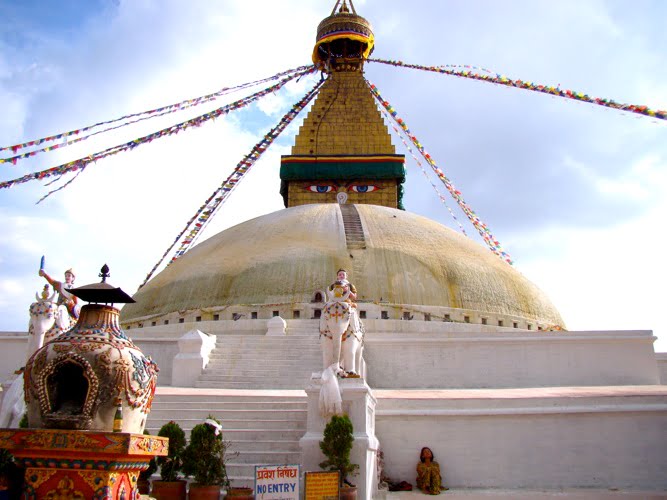
Buddhists circle around this place praying to become pilgrims, and when you give yourself up to the crowd, you start to turn around. The crowd is not the same every hour, it’s up to your luck. Don’t leave here without ringing the bells, lighting the candles, and praying and spinning the cylinders. As a matter of fact, the energy there and what you feel, all this different ambience takes you to different place. You can experience the prayers, dreams, wishes that have passed through your heart in a different mood there.
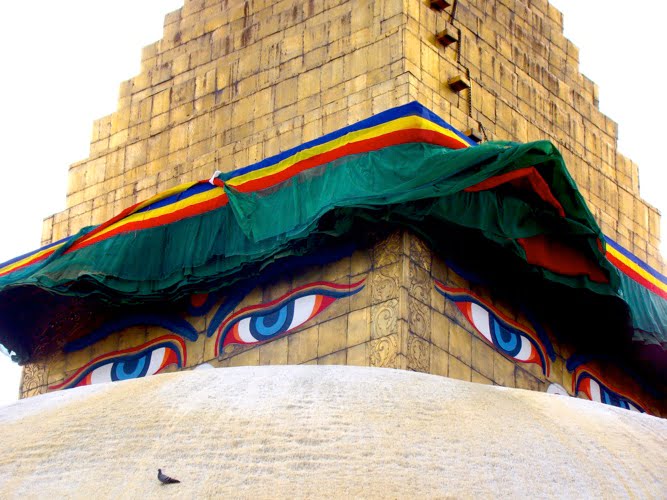
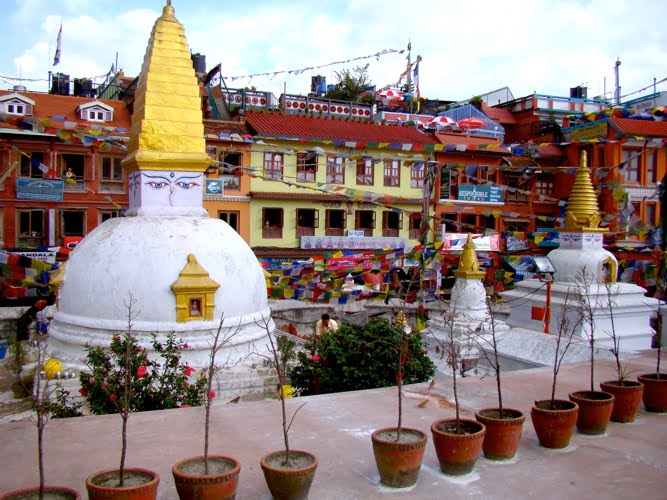
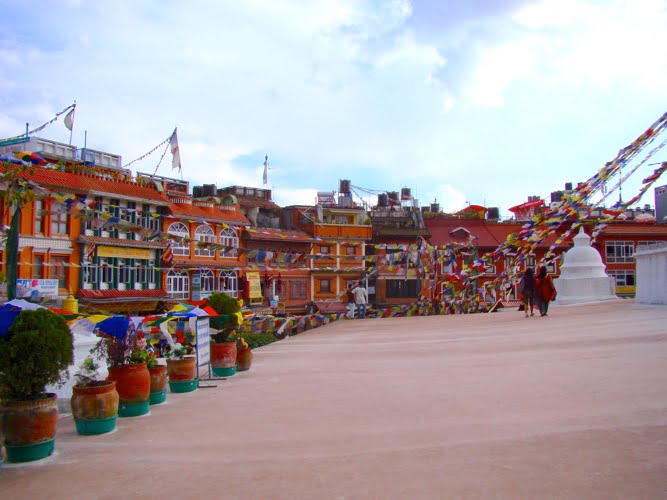
The cafes here have many pleasant roof terraces with views, from where you can fully see the Boudha Stupa. You may be very interested in the surrounding shopping places. I didn’t go at night, but they recommend going at night. If you want, you can go shopping, and if you want, you can sit in a cafe and get tired of the whole day by having a few snacks and an alcoholic drink. Or it’s a nice opportunity to have coffee in the middle of the day and sit on the roof of a café and take pictures.

If you have a good wish or pray that you want to wish for, the atmosphere of this place will help you. You can create a beautiful image for your future.
I’m sharing a photo of the Lacasita de Boudhanath restaurant to help you. You’ll understand what I mean.
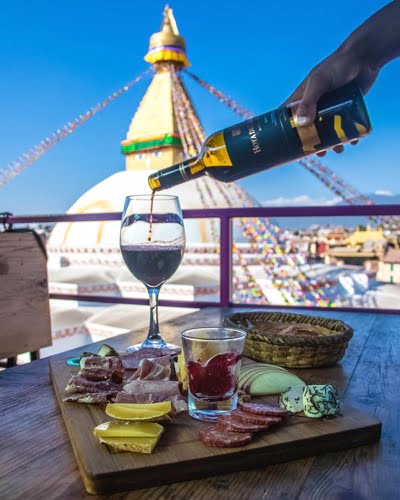
Let’s recommend a few cafés and restaurants opposite and near Bodnath Stupa:
– La Casita de Boudhanath
– Roadhouse Cafe Boudha
– Stupa View Restaurant
– Utpala Cafe
– Nani’s Kitchen
-Toran Restaurant
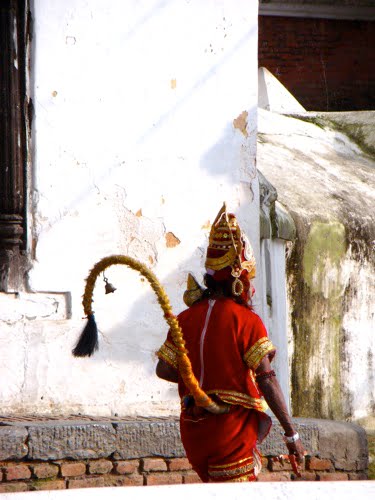
Swayambhunath Temple
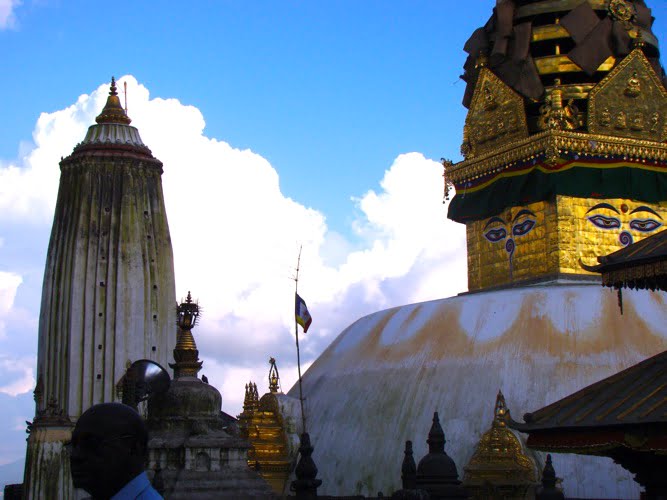
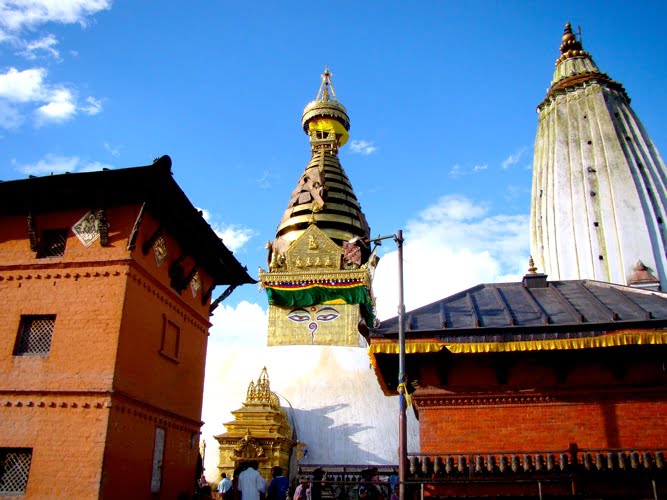
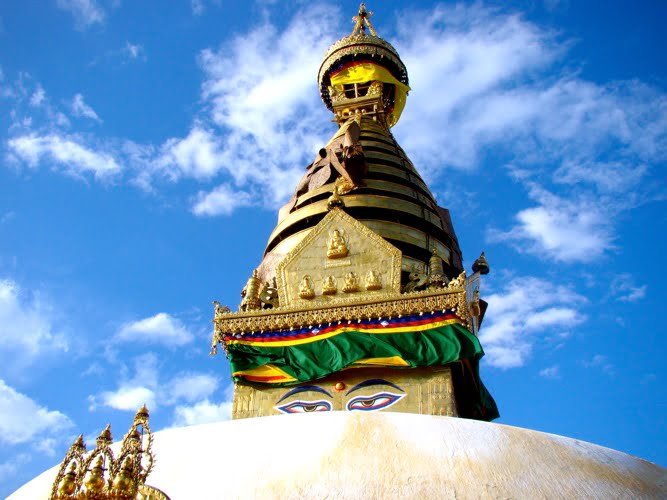
Swayambhunath Stupa (Monkey Temple), a majestic and flamboyant Buddhist temple located on a hill in the Kathmandu Valley, is an ancient religious complex. You can see the whole city and take great photos again from this religious complex located at the top of the valley. There is no doubt that a monkey will enter your frame when taking photos, because this is also known as the Monkey Temple.
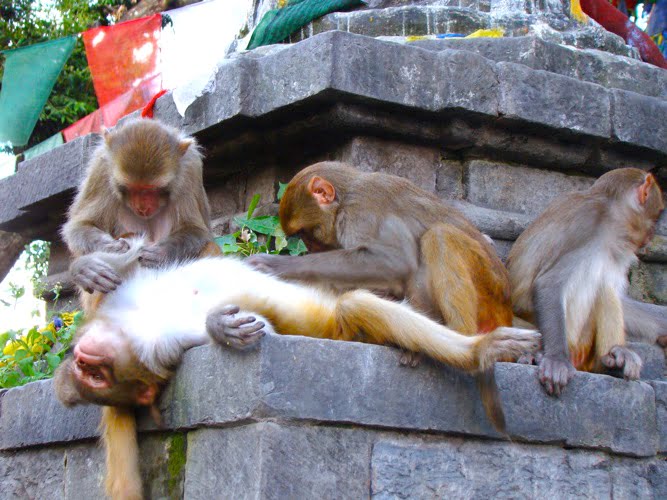
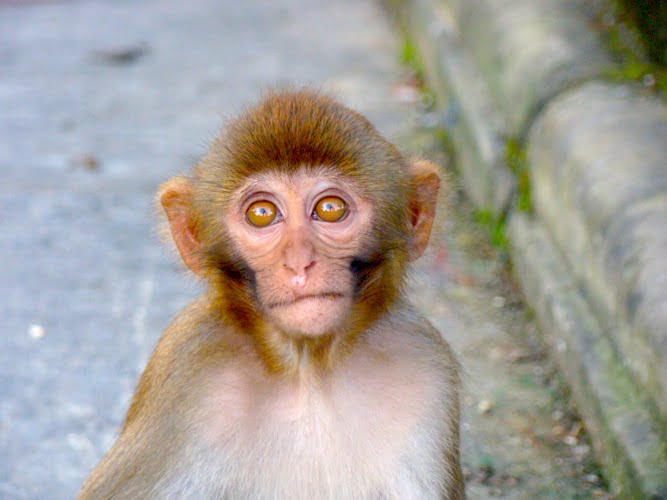
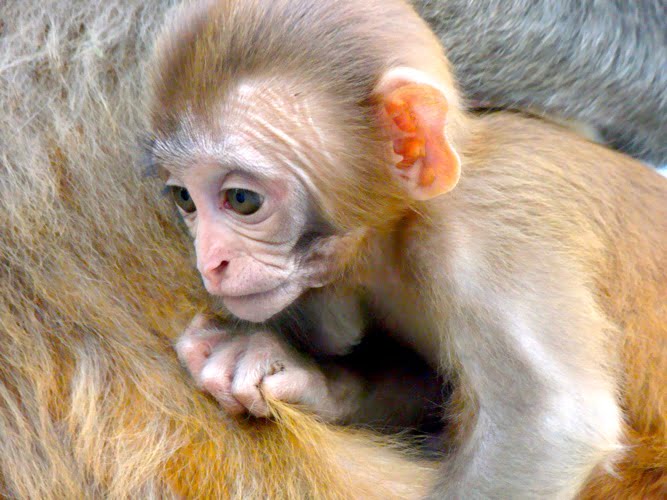
Here, too, you notice a mystical air, you feel much better because the air is cleaner and the noise is less. If you arrive early in the morning, you can climb the long staircase in the fog. You’ll enjoy climbing the stairs, no doubt. Don’t be intimidated by the stairs because this is not the only entrance, there is also another entrance where you can come by car.
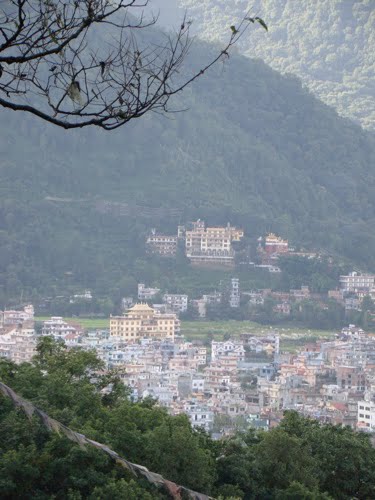
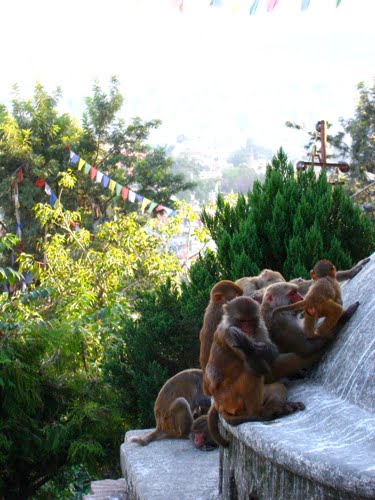
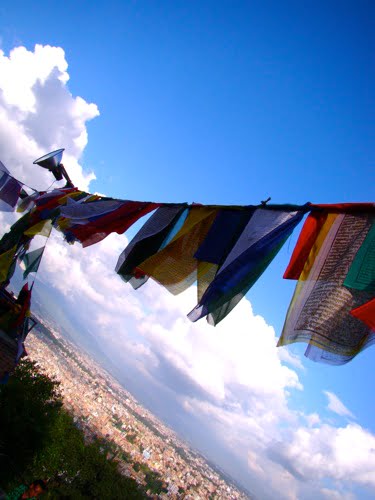
As in all temples, you are greeted by a strong smell of incense. If the smell of monkeys is added to this smell, sometimes it can have a difficult effect to tolerate. If the weather is a bit windy, which can often be windy due to the location of the temple, then these different scents are pleasing. You can hear the rustling of the flags on all sides as you sit in the Swayambhunath Temple and watch the city with the wind blowing.
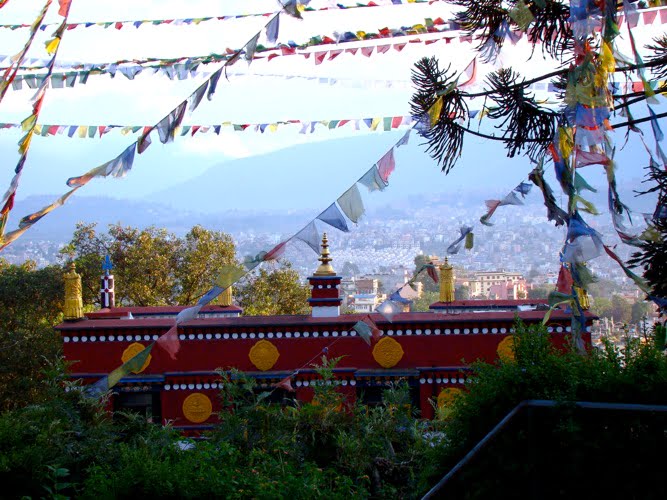
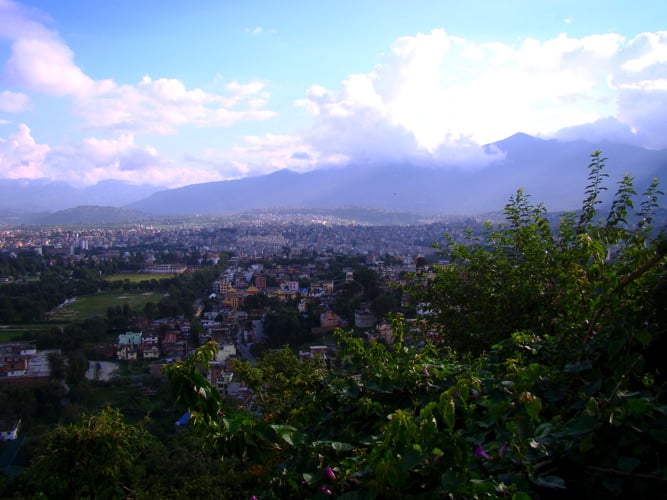
In addition, if you are staying in the Thamel region, it is possible to reach Nepal Swayambhunath Temple by walking, cycling or taxi. 40 min walk from Thamel area.
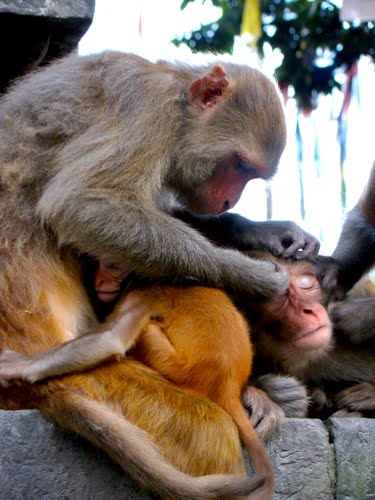
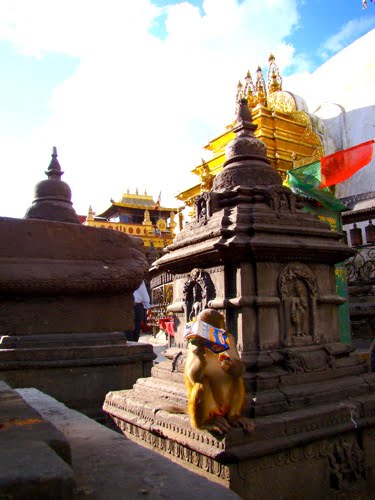
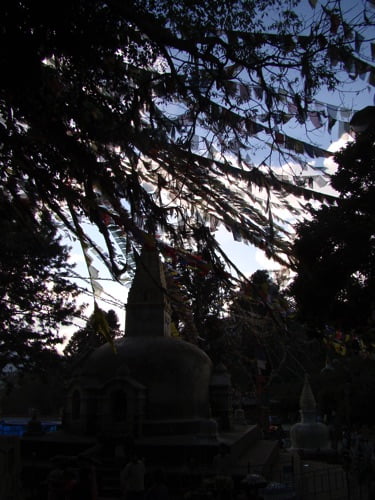
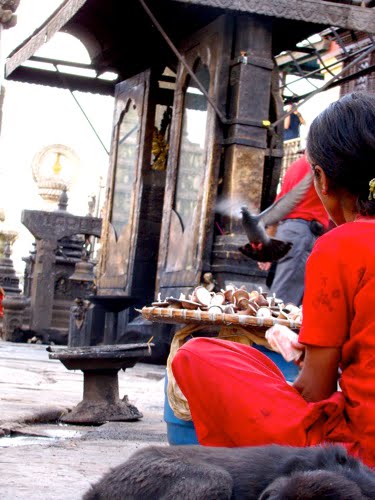
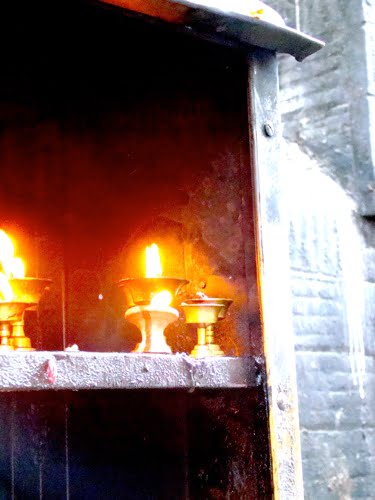
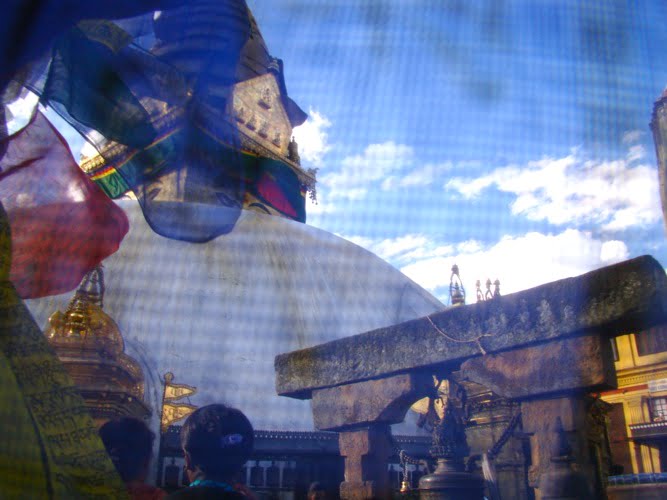
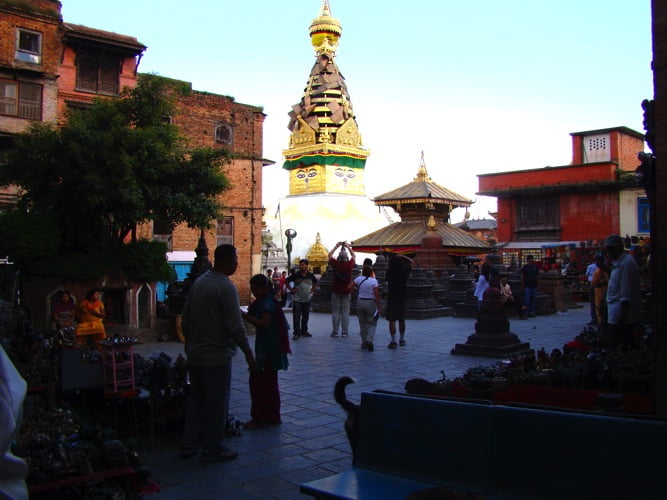
Kathmandu Streets
Do you think the streets of Nepal are meditative?
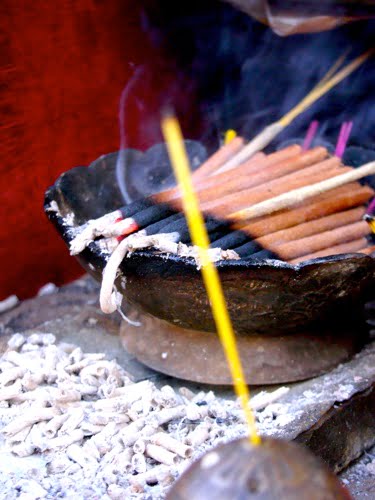
Before I went to Kathmandu, Nepal, I had some dreams and ideas about this city and their lives. I knew they lived meditatively and were sensitive to animals, to nature. I went there different expectations and thoughts in my head. I was dreaming of a clean and green Kathmandu, where spiritual music is heard on the street, people are sensitive to each other and nature. Even in those years, I thought to myself, “When I get old, I can spend my life in the mountains in Nepal”. So, what did I think after I went to Nepal? If you want to die early, yes, you can spend your old age there. Dirty streets where your ears are ringing with the sound of the horn… God, what a noise, what a mess, what a disrespect! Yes, you can hear meditative music on the streets. In front of the shops selling CDs in Thamel (a tourist area), you can hear plenty of this music for sale to tourists. In the streets of Kathmandu, Nepal, in front of butcher-like shops, you can see pieces of meat on big logs, tied with ropes and transported to places with wheelbarrows. Not to mention the dust on the streets. It is not possible for me to tell you about the dust cloud that comes out if the floors are not wet while sweeping. If you do not want to step on feces made by cows and other animals, you should also have one eye on the ground when walking. Not to mention the human garbage that has accumulated enough to be shoveled by the pavement. So you definitely need to be aware of some things and go there. Then it’s okay, you can let yourself go on the big adventure now.
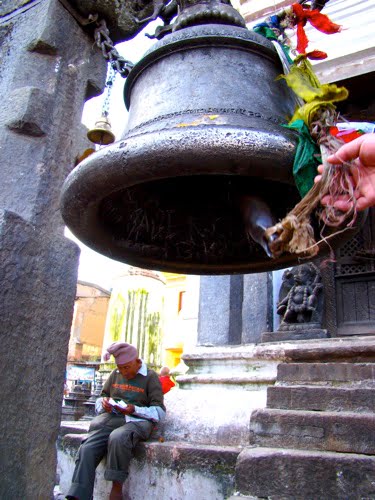
Mandala Street
Could This Be Your Dream Nepal?
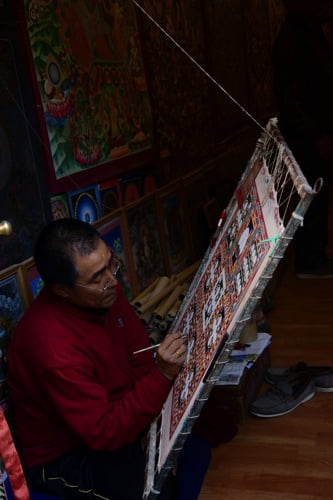
Mandala Street is a place closed to traffic. That’s why you don’t feel the noise and confusion of Thamel much here. In addition, cleaner and more organized shops are waiting for shoppers. It is a small break for those who want to have a drink calmly. But I will tell you something very interesting: Once you feel the turmoil, intensity and excitement of Nepal, Thamel, you realize that this is not the real Nepal. And a force still pulls you into the streets of Thamel. You feel like there’s a festival out there and you’re missing something.
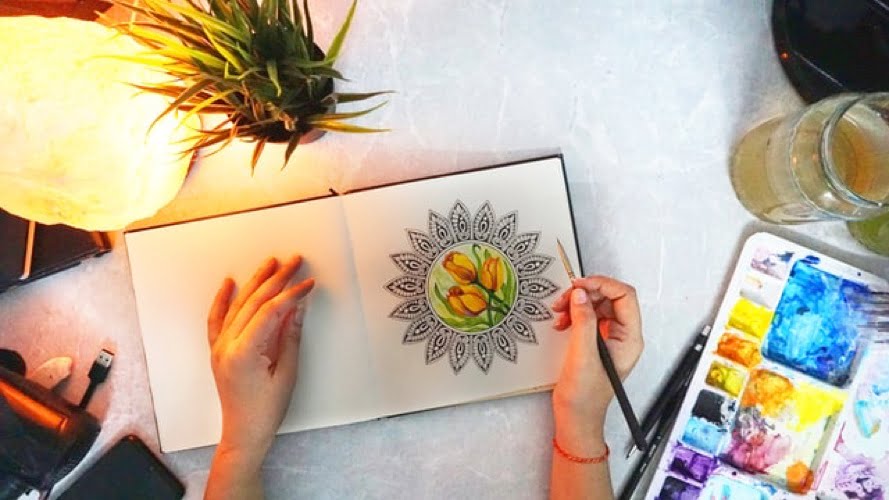
In addition, wonderful works on mandala are made here. You can only buy things from places where you believe you won’t get ripped off. Mandala is a drawing technique used to describe micro and macro cosmos. By repeating the tiny pattern, you get larger versions of the same picture. It means “circle” in Sanskrit. Depending on the size or difficulty of the mandala, it can take days to draw. You can go to Mandala Street to see a few mandalas, or even to buy them.
Should You Get a Massage in Nepal?
A Massage Experience on the Streets of Thamel, Kathmandu
As we wandered the streets of Thamel, we caught our eye with a few massage parlors. We were actually very ambivalent because we didn’t know if there was a place around here that massaged really well. We couldn’t find very good places as a result of our internet research. So getting a massage was not at the top of the to-do list in Kathmandu. But one day when we were very tired, my cousin and I entered a parlor. We didn’t have high expectations, but I had one of the best massages I’ll never forget. I don’t fall asleep during the massage but we were either very tired or they had a really good massage. That’s hard for me to tell you! No matter what, it became one of the most memorable massages for me. What can we figure out from this? The need for the massage was as important as the good massage.
Which temples in Nepal mean what?
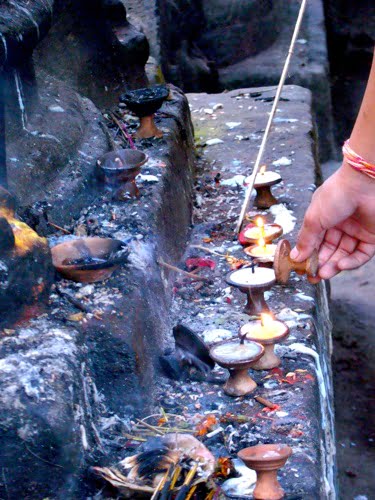
We were sometimes confused as to which temple belonged to the Hinduism&Buddhism religion. Because there are so many religions and gods here that after a point we started to get confused. If you think that Muslims also live in Nepal, you will understand that there is a festival of religions. For me, the most beautiful feeling in the world is that whoever has any belief should be able to live it. After all, spirituality is a connection between you and your god. As a matter of fact, they need a power that is a light for people to pray, take shelter and find the right path. That’s why a geography where you can live by respecting each other is the most peaceful one. Let’s see briefly what the most common temple models in Nepal are.
Pagoda Type

You know, there is an architecture that we often come across in Far Eastern movies, the Pagoda type is exactly like that. It’s referred to as a Buddhist temple. You can often see it in China, Japan, India and Nepal.
It is usually multi-storey and rectangular in appearance. Pagodas range from five to thirteen floors. The original Pagodas are a religious structure called Stupa by Indians. Towers that are high are sometimes also used to spy on the city for military purposes.
Stupa Type

Stupas built for the burial of kings in India later became Buddhist temples. They represent the Buddha and the Dharma, the doctrine of the Buddha. It is in the shape of a half dome. Boudhanath and Swayambhunath will surely be among the places you will see when you go to Kathmandu. These are beautiful structures that will set an example for the type of Stupa. You can also see the big eyes of Buddha on it.
Shikhar Type
Shikhar type temples are Hindu temples. It is much more common in India than in Nepal. But when you go to Durbar Square, you’ll see these temples there. When you see the Patan Temple in Durbar Square, resembling a glass of water, you’ll know what I mean.